#16th c. Holy Roman Empire
Text

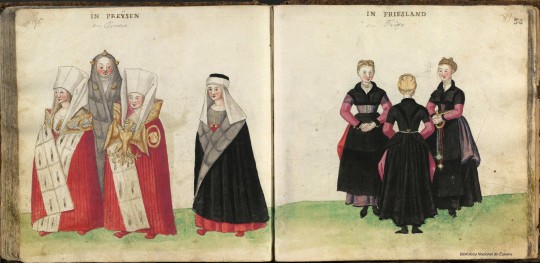


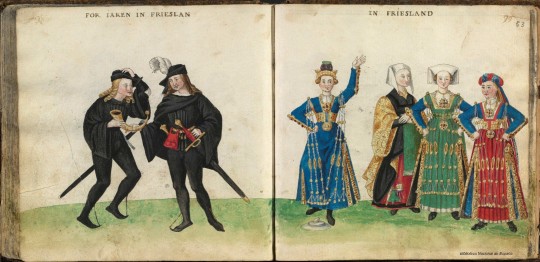

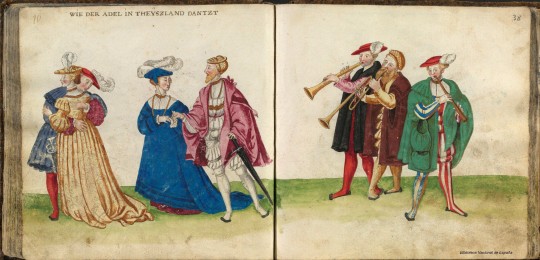
Códice de Trajes, costumes from the realms of Charles V, Holy Roman Emperor and King of Spain, made in Germany in mid 16th century (1540s-1550s)
Prussia
Prussia and Friesland
Schwabia and Elzach
Juelich
Frisia
Germany
German dance
#germany#manuscript#16th century#mdpillustration#illustration#costume illustration#1540s#1550s#holy roman empire#16th c. holy roman empire#prussia#mid 16th century
410 notes
·
View notes
Text





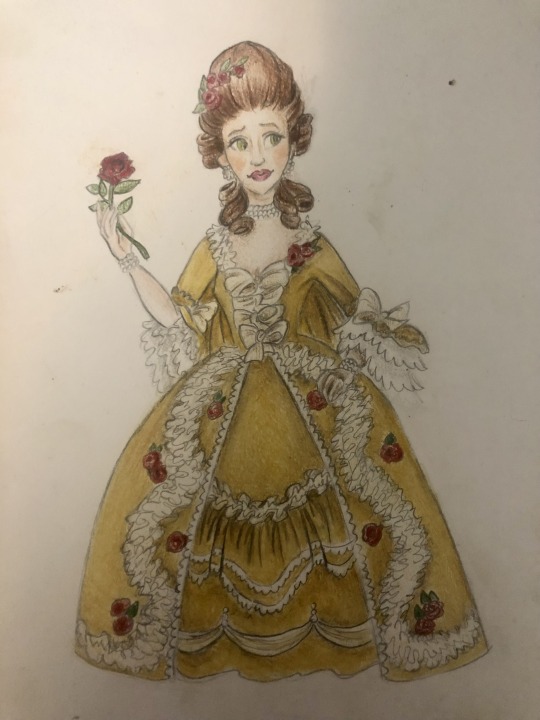
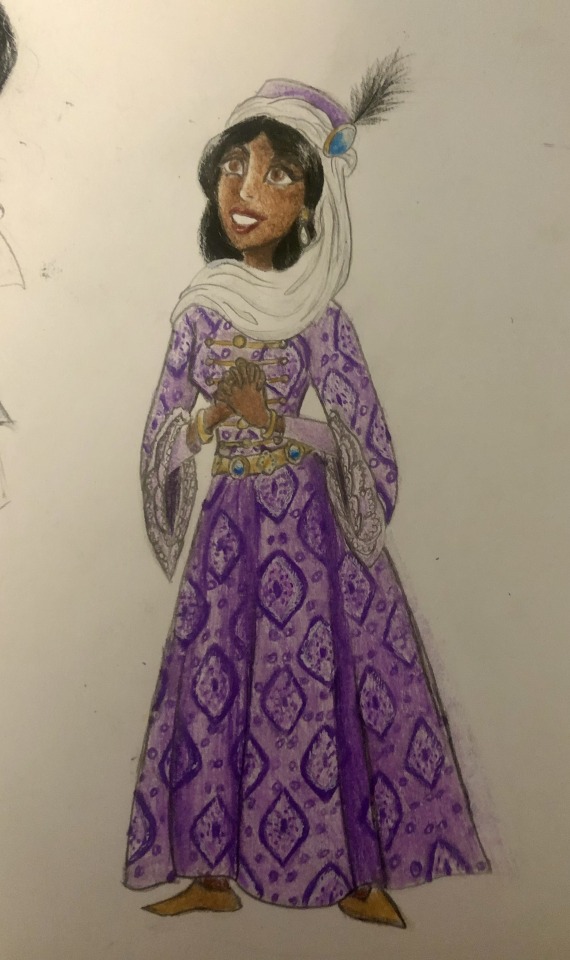


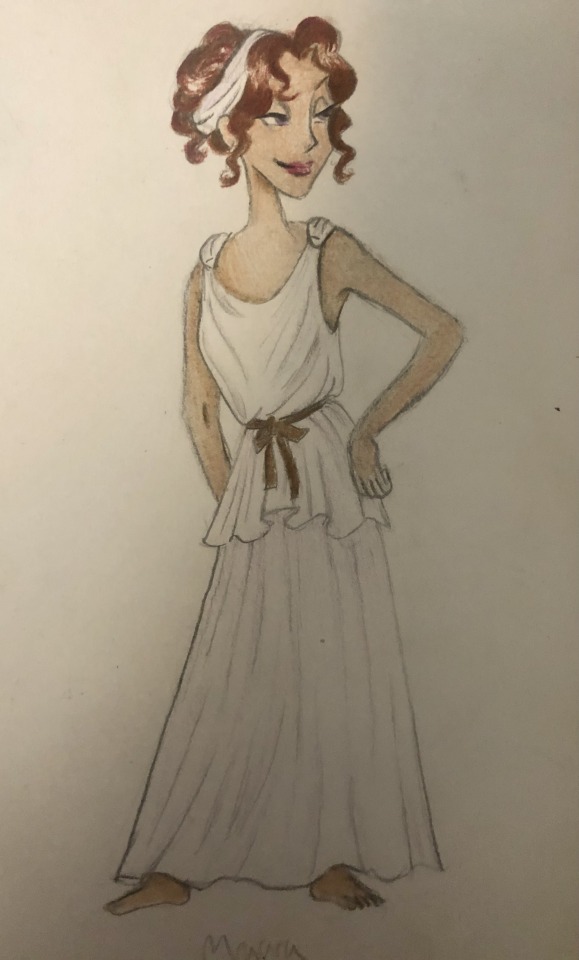


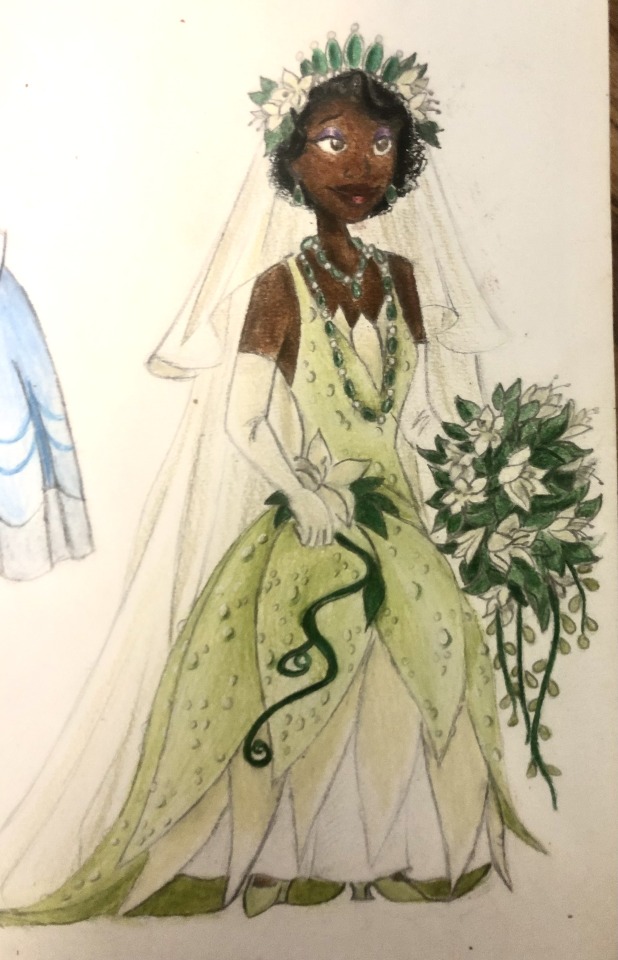



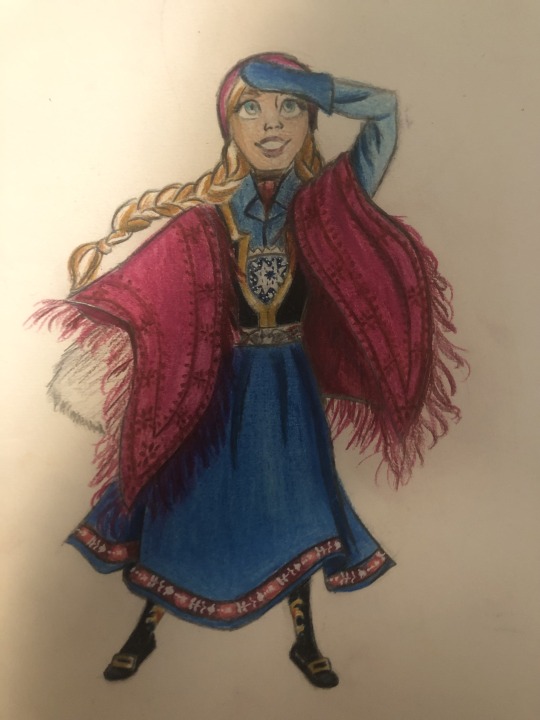

Thought I’d do a little art throwback with my own historically accurate (well mostly) takes on Disney princesses and heroines, which I did from 2021 to 2022! Included in this series are:
Snow White - early 16th century Germany (then part of the Holy Roman Empire)
Cinderella - late 1860s-early 1870s France
Aurora - mid 15th century France
Eilonwy - 8th-10th century (present day) Wales
Ariel - 1830s Mediterranean Europe (maybe Italy)
Belle - 1760s-1770s France
Jasmine - 16th century Arabian Peninsula during the Ottoman Empire
Pocahontas - 1607 Virginia, (present day) United States of America
Esmeralda - 1480s France (Romani garb)
Megara - Classical period of Ancient Greece (c. 5th-4th centuries BCE)
Mulan - Wei Dynasty China (386-535 AD)
Jane - 1900s England
Tiana - late 1920s New Orleans, Louisiana, USA
Rapunzel - 1790s-1800s Germany
Merida - 10th-11th century (present day) Scotland
Elsa - late 1830s-early 1840s Norway
Anna - same period as Elsa (duh)
Moana - ancient Polynesian Islands (c. 1st century BCE)
I had so much fun drawing these, as well as doing the research for each one! I actually drew most of the outfits each one wears (in their first movies) but they're waaaaay down further in my blog.
I'm planning to do a digital redo of these someday, as well as do my own historical spins on other characters I haven't done yet.
Which one is your favorite?
#my art#angie's scribbles#disney#disney princess#disney princesses#disney heroines#disney girls#disney ladies#historical disney#historically accurate disney#historical fashion#snow white#snow white and the seven dwarfs#snow white 1937#cinderella#cinderella 1950#princess aurora#aurora#sleeping beauty#sleeping beauty 1959#eilonwy#princess eilonwy#the black cauldron#ariel#the little mermaid#the little mermaid 1989#belle#beauty and the beast#beauty and the beast 1991#jasmine
47 notes
·
View notes
Note
Im in love with the way you draw clothing!! Love how you use lots of sharp lines and yet you make it look nice and fluid!!! and i specially love how you draw armor!! if I may ask, how do you approach drawing those? ;o; and do you have some tips on how to approach it? totally cool if you don’t feel comfy with that tho! hope you’re doing great!! c:
hi! this took awhile because it's hard for me to explain how i draw fabrics, i just kind of do it ha. i'll try to explain though!

i think about fabric materials, tension points, and the fact that fabric usually folds in triangle or V patterns. that last point is why i find fabric so fun to draw! you can have a really angular and/or sharp style, but that's how clothes fold anyway :) i also drew a quick comparison of the way a heavy fabric like wool and a light gossamer fall bc of their weight/thicknesses.
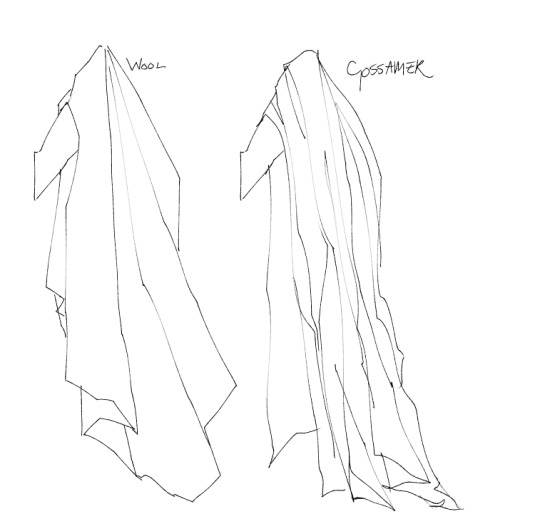
NOW WITH ARMOR. with armor. <3
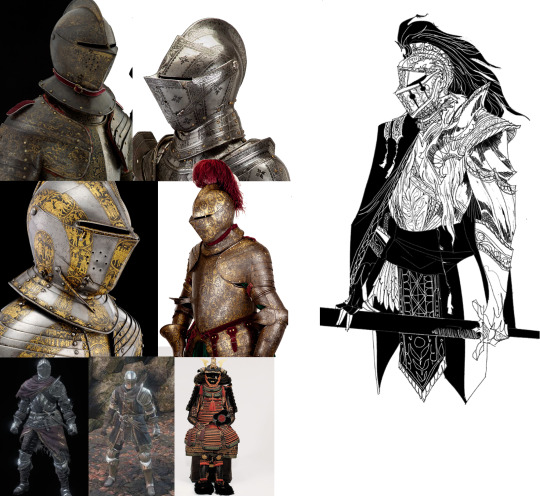
i'm using this piece as an example. on the left was the moodboard of armor I made for that. mostly i reference 16th c armor found in the holy roman empire, but some english armor slips in there too. i also really like how japanese armor comes together, especially maru do chestplates. because i'm a fantasy artist, and started as one, i ignore reality when it's convienent in the sake of armor looking cool. i like armor looking nice and shiny so i color it like silver: really dark against really light. etchings and engravings on armor are delicate, so i try to get that accross too. honestly i learned a lot about how i wanted armor to look by playing dark souls 3, ha
#ask#fun fact. when i was a child my mom had the official diablo 2 strategy guide in paperback and it had a lot of concept art#and i would spend all day when i was like 10 just tracing over the armor in the book bc i loved it so much LOL#thoughout writing that armor section i kept going do NOT ramble about the history of landsknecht dont you DARE#if this posts right aligned just know i dont know how the fuck i did that#and i dont know how to fix it but i had it almost all written up#so i wasnt redoing all that#hold on i didnt just right align this ask i right aligned...the entire website...#help
39 notes
·
View notes
Text
Today the Church honors Pope St. Cornelius.
Ora pro nobis.
Pope Saint Cornelius was a Roman priest who was elected pope during the lull in the persecution of Christians under Emperor Decius (AD 249–251).
During the period of persecution under Emperor Decius, and after the martyrdom of Pope Saint Fabian, the Roman Church was unable to elect a new pope. During the persecution it proved impossible to elect a successor, and the papal seat remained vacant for over a year. In the fourteen months without a pope, the leading candidate, Moses, had died under the persecution. In AD June 251, Decius was killed in battle with the Goths, which provided a brief window for the election of a new bishop of Rome.
Although Novatian was the pre-eminent theologian in Rome, and the first Roman theologian who used the Latin language rather than Greek in his writings, and who had largely administered the Church of Rome during the period of persecution (for which he expected to be elected pope), the moderate Roman Cornelius was elected over Novatian and others as the twenty-first pope in AD March 251. Novatian then proclaimed himself pope, and the Church of Rome fell into schism.
Those who supported Novatian and his rigorist position, that the lapsed could not be re-admitted to the Church under any circumstances, had Novatian consecrated bishop and refused to recognize Cornelius as Bishop of Rome. Both sides sent out letters to other bishops seeking recognition and support. Cornelius had the support of Cyprian, Dionysius, and most African and Eastern bishops while Novatian had the support of a minority of clergy and laymen in Rome. Cornelius's next action was to convene a synod of 60 bishops to acknowledge him as the rightful pope. The synod excommunicated Novatian as well as all Novatianists. Also addressed in the synod was that Christians who stopped practising during Emperor Decius's persecution could be re-admitted into the Christian community only after doing penance.
The verdict of the synod was sent to the Christian bishops, most notably the bishop of Antioch, a fierce Novatian supporter, in order to convince him to accept Cornelius as bishop of Rome. The letters that Cornelius sent to surrounding bishops provide information of the size of the church in Rome at that time. Cornelius mentions that the Roman Church had, "forty six priests, seven deacons, seven sub-deacons, forty two acolytes, fifty two ostiarii, and over one thousand five hundred widows and persons in distress." His letters also inform that Cornelius had a staff of over 150 clergy members and the church fed over 1,500 people daily. From these numbers, it has been estimated that there were at least 50,000 Christians in Rome during the papacy of Pope Cornelius.
As a side note, all Christian worship throughout the world was originally offered in Greek (the language of the New Testament), the Scriptures were read in Greek, and all scholarly theological writing was in Greek. Translations of the Gospels began to appear in the 4th c. AD in regional languages, such as Syriac, Gothi, Ge’ez, Armenian, Coptic, and Georgian, which also shaped growing provincial changes in the liturgy. In the Western Church, translations of the Gospels into Latin began to be made piecemeal by various translators in the early 4th c. AD, which collectively are called the Vetus Latina. It was not until the Vulgate translation (vulgate meaning “vulgar”, the Latin word for “common”, referring to the common language of Rome, Latin) was commissioned by Pope Damasus I in AD 382 that a singular, authoritative Latin version of the Holy Scriptures that Latin began to replace Greek as the language of worship and scholarship in Western half of the Roman Empire. It is a sad note of history that in the 16th c. translations began to be made into regional languages because very few could read Latin, just as had been commissioned by Pope Damasus in AD 382. Latin was a dead language, and mostly only scholars could read or speak it. Even the average clergy not trained as scholars could barely read it, and in the liturgy the people were reciting prayers with little to no comprehension. The response of the Roman Church was regrettably intolerant and violent, and was no small part of what precipitated the Protestant Reformation. Today, no matter the language used in Western Christianity, during the liturgy we can still see the vestiges of the Greek liturgy, such as when we pray “Kyrie Eleison, Christie Eleison, Kyrie Eleison”. The Vulgate is largely the work of Jerome who, in AD 382, had been commissioned by Pope Damasus I to revise the Vetus Latina Gospels used by the Roman Church. Later, on his own initiative, Jerome extended this work of revision and translation to include most of the books of the Bible. The Vulgate became progressively adopted as the Bible text within the Western Church.
The persecutions resumed in AD 251 under the new Emperor Trebonianus Gallus (AD June 251 to August 253). Cornelius was exiled to Centumcellae, Italy, where he died in AD June 253. The Liberian catalogue ascribes his death to the hardships of banishment; later sources say he was beheaded.
Almighty God, by whose grace and power your holy martyr Cornelius triumphed over suffering and was faithful even to death: Grant us, who now remember him in thanksgiving, to be so faithful in our witness to you in this world, that we may receive with him the crown of life; through Jesus Christ our Lord, who lives and reigns with you and the Holy Spirit, one God, forever and ever.
Amen.

#father troy beecham#christianity#jesus#god#saints#salvation#peace#martyrs#faith#early church#repentance#forgiveness#hope
3 notes
·
View notes
Text

The Holy Roman Empire Gernstein Castle, Italy 🇮🇹 😍 Gernstein Castle – South Tyrol, Italy – Built 12th c. by Heinrich Garre, Ministerial of Bressanone – Passed to the Counts of Heydorf 1550 – Abandoned late 16th c. – Restored by Prussian Lieutenant General Friedrich von Gerstein-Hohenstein 1880 – Currently a private residence not open to the public.
#fortezza #castlemypassion #castlesofeurope #borghitalia #italia #italy #italygram #italytravel #italytrip #italy🇮🇹❤️ #italy_vacations #italyiloveyou #madeinitaly #italytourism #castlesoftheworld #castlesofeurope #castlesofinstagram #castles_oftheworld #europeancastles #castles #bestcastles #castles🏰 #höhenburg #castlesofitaly #schloß #chateau #chateaux #kasteel #HolyRomanEmpire 👉👉👉👉📸 @steiger_photography — em Castello di Gernstein
3 notes
·
View notes
Text

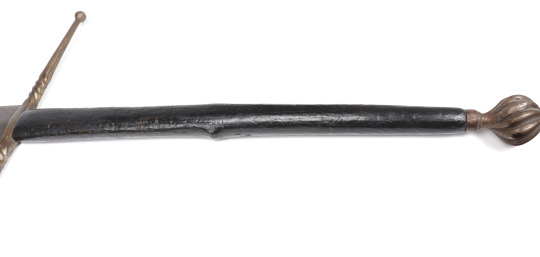
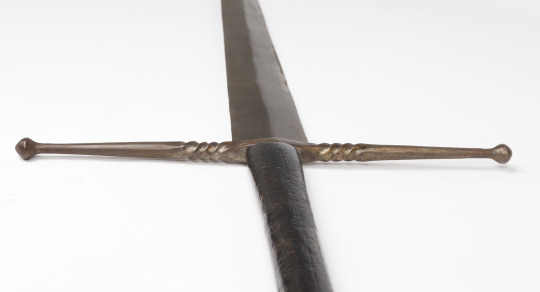

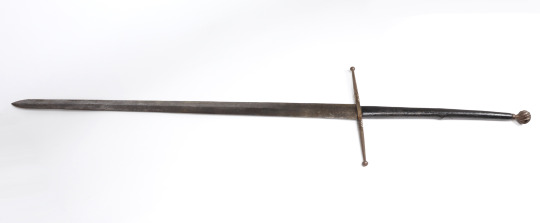

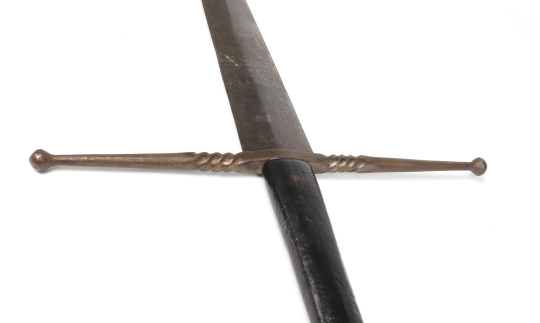

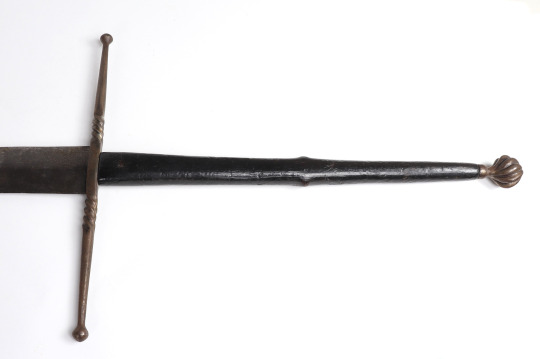
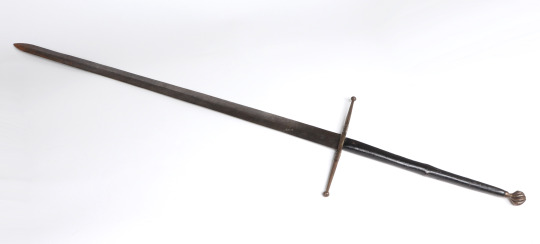

Europe, Probably German or Italian 16th C. style but of circa 1800-1890s. Massive Landsknecht two-hand sword in the German or Swiss style with a bulbous twisted iron pommel, old replaced leather grip that measures over 18" alone and features a raised center section for grip, the crossguard is a straight quillion and partially twisted iron with bulbous ends. The blade double edged and a straight diamond cross section shaped with minimal taper to a pointed tip absent parierhaken. Swordsmiths mark to one side consisting of three dots and straight line. 7lbs 10.8oz 63" L, blade 41 3/4" L
Earlier examples of Zweihanders were large versions of long sword absent parierhaken and of a plain shape as the example above. A favorite weapon among early South German mercenary and foot solider that only master swordsman carried. Originally organized by Maximilian I 1459-1519 the group of mercenaries or Landsknechte composed a large portion of the Holy Roman Empires Army from the late 1400s thru early 1600s. Their temperament known as mutinous if unpaid earned them a reputation and dangerous and fierce warriors.
#Swords#collecting#bidding#auctioneer#auctions#auctionsnow#collectingswords#collectingantiques#antiques#Germansword#germanantique
0 notes
Photo
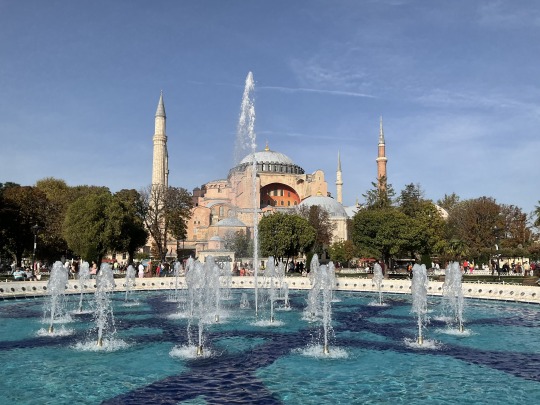


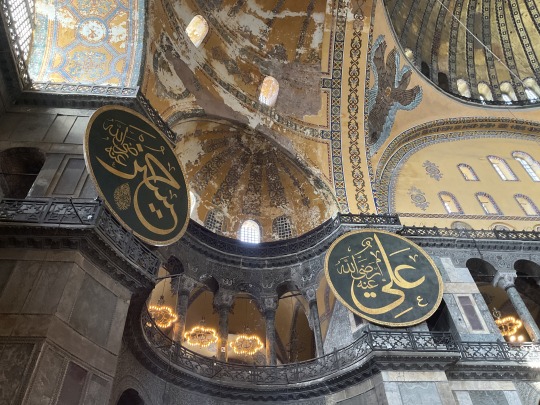


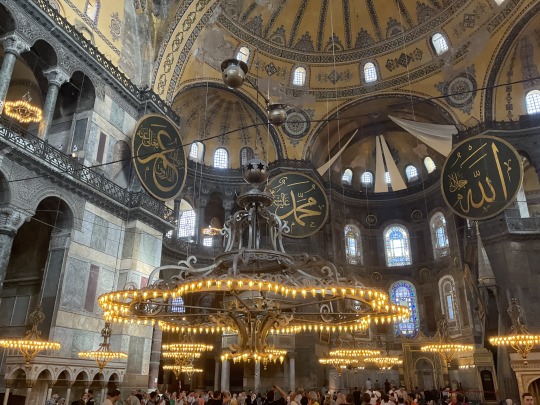
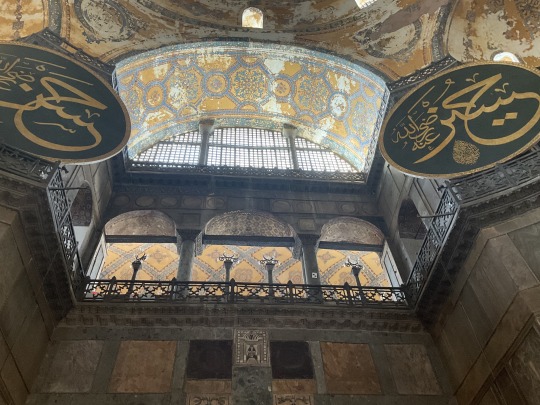


Istanbul: Hagia Sophia was built in 537, with minarets added in the 15th–16th centuries when it became a mosque.
Byzantine Christian cathedral (c. 360–1204, 1261–1453)
Latin Catholic cathedral (1204–1261)
Mosque (1453–1935)
Museum (1935–2020)Mosque (2020–present)
Originally built by the eastern Roman emperor Justinian I as the Christian cathedral of Constantinople for the state church of the Roman Empire between 532 and 537, and designed by the Greek geometers Isidore of Miletus and Anthemius of Tralles, it was formally called the Church of the Holy Wisdom, and was then the world's largest interior space and among the first to employ a fully pendentive dome. It is considered the epitome of Byzantine architecture and is said to have "changed the history of architecture".
0 notes
Text
History of Syro Malabar Church
From St. Thomas Syro-Malabar Catholic Church in Bronx, NY.

The Syro Malabar Church is one of the 21 Oriental Rites in the Universal Church.
The Apostles went around the world and preached the Gospel of Jesus Christ to different ethnic groups and cultures. Those people understood the Gospel Values with different cultural interpretations. They expressed their Faith through celebrations in different styles, languages, & cultures. Thus different Liturgies were formed and developed in the East which are listed in 5 Fundamental Families, namely: Alexandrian, Antiochean, Armenian, Chaldean, and Byzantine. And there are many different filial Churches in each Family.
And Latin Liturgy was developed in the West.
The Church made it’s distinction of East and West depending upon the 2 Capitals of the Great Roman Empire. All the Churches which came under the Capital City of Rome were called the Western Churches and all the Churches which came under the Capital City of Constantinople (Byzantium) were called the Eastern Churches.
Among the Eastern Churches, there are six Patriarchal Churches:
Coptic
Syrian
Maronite
Armenian
Chaldean
Melkite
There are two Major Archiepiscopal Churches:
Ukranian
Syro Malabar
The Syro Malabar Church was founded by St.Thomas, one of the 12 Apostles, who came to India in AD 52. He preached in different Kingdoms all around the Subcontinent and established seven and a half Ecclesial Communities in Malabar, today called Kerala. After 20 years of His Mission Work, He was martyred in Mylapore, near Madras by a fanatic Hindu priest on July 3rd in AD 72. The whole world celebrates the Martyrdom of St.Thomas on July 3rd and it is a day of obligation for the Syro Malabarians.
The early Christians of India were converted from the High Caste Hindus. They were ;called St.Thomas Christians and they developed into an Indigenous Individual Church until the 4th century.
Then the Persians came and dominated over the Indian Church and imposed their Chaldean Liturgy over us for about 1000 years. They were importing bishops from Persia from the Chaldean Church. They never ordained an Indian Bishop.
When the Portuguese arrived and colonized India in the beginning of the 16th century, they also imposed their Latin Liturgy and latinized us and restricted our freedom of development for 4oo years. They were also importing Bishops from abroad and they never ordained any Indian Bishop. They burned our Liturgical Texts and Vestments.
We were liberated by Pope Pius IX in 1896 by establishing a Syro Malabar Hierarchy. But this dynamic Church’s operations were limited to a very small territory between two rivers; namely: Pambayar and Bharatha Puzha. We were not allowed to do Mission Work in Our Own Rite. Those who wanted, had to adopt the Latin Rite. Only in 1952, the late Cardinal Tisserant, Prefect of the Oriental Congregation, who studied our history and knew the beauty of our Church, recommended to the Holy Father to remove those barriers .
Then Pope Pius XII extended our proper territory to Malabar, Mysore, Nilgiris and Trivandrum and established the Diocese of Tellicherry for the migrants from the South. And it was a mile stone in the progress of our Church.
On October 18th,1990, the Code of Canon Law for the Oriental Churches was promulgated in Rome.
After repeated memorandums by the Syro Malabar Bishops’ Conference, His Holiness Pope John Paul II raised our Church on May 20th, 1993 to the Status of a Major Archiepiscopal Church which is next only to a Patriarchal Church in rank and appointed Mar Antony Cardinal Padiyara, our first Major Archbishop, and Archbishop Mar Abraham Kattumana, it’s Pontifical Administrator.
The famous saying of Cardinal Tisserant is worth quoting: The Syro Malabar Church, established in India by St.Thomas the Apostle, is “Christian in Faith, Oriental in Worship, and Indian in Culture.”
This Particular and Individual Church plays a vital role in the missionary and evangelical activities of the Catholic Church around the world. Every year it admits over 2500 candidates for priesthood and religious life, 1500 of whom dedicate themselves to serve in other communities worldwide. Approximately 500 Syro Malabar priests and few hundred nuns serve in various Mission Centers throughout the USA and Canada.
Today, the Syro Malabar Catholic Church is a Sui Juris Particular Church, headed by His Eminence Mar Varkey Cardinal Vithayathil, the 2nd Major Archbishop. It has four Archdioceses, twenty suffragan dioceses and approximately 3000 parishes and semi- parishes. At present, there are fifty five bishops belonging to the Syro Malabar Rite: thirty two serving in Syro Malabar Dioceses and twenty three serving in other dioceses and apostolic offices. There are about 8000 priests in the ministerial priesthood. This makes a remarkable ratio of about one priest for every 500 faithful – an unprecedented number among other Churches. Moreover, 2500 seminarians are studying in various seminaries to join the priesthood. The Syro Malabar Church has approximately one female member in the various Institutes of Consecrated Life and Societies of Apostolic Order for every 100 members.
The name of our Church was ( Mar Thoma Nazranikal ) which means “Nazrenes of St.Thomas”. In the 19th century, the Oriental Congregation had renamed our Church as Syro Malabar Church. Our Bishops’ Synod has already passed a resolution to change the name of our Church from Syro Malabar Church to “The Church of St.Thomas Christians”.
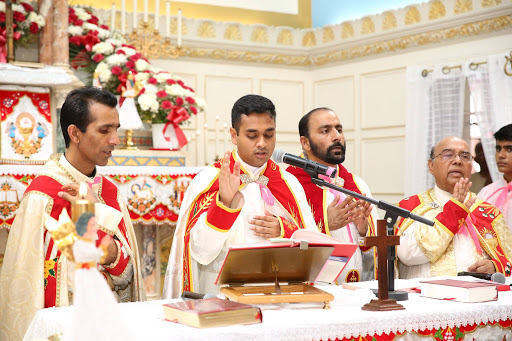
The main teachings of the Vatican II on Eastern Churches:
a) “All the members of the Eastern Rites should know and be convinced that they can and should always preserve the legitimate liturgical Rite and their established way of life, and that these may not be altered except to obtain for themselves an organic improvement. All these things ;must be observed by the members of the Eastern Rites themselves”. ( Vatican II, Orientalium Ecclesiarum: #6 ).
b) “Each and every Catholic (of Eastern Rites) must retain, each his own Rite wherever he is, and follow it to the best of his ability”. ( #4 )
c) “Those individual Churches of East or West are….of equal rank so that none of them is superior to others because of its Rite”. ( #3 )
d) “All members of the Eastern Churches are to aim always at a more perfect knowledge and practice of their Rites and if they have fallen away due to the circumstances of times and persons, they are to strive to return to their ancestral traditions.” ( #6 )
[Read More]
Prepared by Fr.Jos Kandathikudy
52 notes
·
View notes
Photo

Lucas Cranach the Elder - Portrait of the Elector John Frederic the Magnanimous of Saxony - 1531
Johann Frederick I (German: Johann Friedrich I; 30 June 1503 in Torgau – 3 March 1554 in Weimar), called Johann the Magnanimous, was Elector of Saxony (1532-1547) and head of the Schmalkaldic League.
He consolidated the Lutheran State Church by the institution of an electoral consistory (1542) and renewed the church visitation. He took a firmer and more decided stand than his father in favor of the Schmalkaldic League, but on account of his strictly Lutheran convictions was involved in difficulties with the Landgrave of Hesse, who favored a union with the Swiss and Strasburg Evangelicals. He was averse to all propositions of Popes Clement VII and Paul III to support calling a General Council, because he was convinced that it would only serve "for the preservation of the papal and anti-Christian rule"; but to be prepared for any event, he requested Luther to summarize all articles to which he would adhere before a council, and Luther wrote the Schmalkald Articles. At the Diet of Schmalkalden in 1537 the council was refused, and the elector treated the papal legate with open disregard and rejected the propositions of Dr. Held, the imperial legate.
The Schmalkaldic League (German: Schmalkaldischer Bund; Latin: Foedus Smalcaldicum) was a military alliance of Lutheran princes within the Holy Roman Empire during the mid-16th century. Although originally started for religious motives soon after the start of the Reformation, its members later came to have the intention that the League would replace the Holy Roman Empire as their focus of political allegiance.While it was not the first alliance of its kind, unlike previous formations, such as the League of Torgau, the Schmalkaldic League had a substantial military to defend its political and religious interests. It received its name from the town of Schmalkalden, which is located in modern Thuringia.
The formation of the Smalcald League in 1531 and the threatening attitude of Sultan Suleiman the Magnificent, who, in April 1532, assumed the offensive with an army of 300,000 men, caused Ferdinand of Austria to grant the religious peace. Ferdinand had made humiliating overtures to Suleiman and, as long as he hoped for a favourable response, was not inclined to grant the peace, which the Protestants demanded at the Diet of Regensburg, which met in April 1532. However, as the army of Suleiman drew nearer, he yielded, and on July 23, 1532 the peace was concluded at Nuremberg, where the final deliberations took place. Those who had joined the Reformation obtained religious liberty until the meeting of a council and in a separate compact all proceedings in matters of religion pending before the imperial chamber court were temporarily paused.
After Charles made peace with Francis in 1547, he focused on suppressing Protestant resistance within his empire. From 1546 to 1547, in what is known as the Schmalkaldic War, Charles and his allies fought the League over the territories of Ernestine Saxony and Albertine Saxony. Although the League's military forces may have been superior, its leaders were incompetent and unable to agree on any definitive battle plans. Despite the fact that Pope Paul III withdrew his troops from the Imperial forces and halved his subsidy, on 24 April 1547, the imperial forces gathered by Charles routed the League's forces at the Battle of Mühlberg, capturing many leaders, including, most notably, Johann Frederick the Magnanimous. Philip of Hesse tried to negotiate, but the emperor refused, and Philip surrendered in May. In theory, that meant that the residents of thirty different cities were returned to Catholicism, but that was not the case. The battle effectively won the war for Charles; only two cities continued to resist. Many of the princes and key reformers, such as Martin Bucer, fled to England, where they directly influenced the English Reformation.
In 1548, the victorious Charles forced the Schmalkaldic League to agree to the terms set forth in the Augsburg Interim. However, by the 1550s, Protestantism had established itself too firmly within Central Europe to be ended by brute force. A small Protestant victory in 1552 forced Charles to flee across the Alps to avoid capture; the heir Ferdinand (King of the Romans) signed the Peace of Passau, which granted some freedoms to Protestants and ended all of Charles' hopes of religious unity within his empire. Three years later, the Peace of Augsburg granted Lutheranism official status within the Holy Roman Empire and let princes choose the official religion within the domains that they controlled, according to the principle of Cuius regio, eius religio.
Lucas Cranach the Elder (German: Lucas Cranach der Ältere German, c. 1472 – 16 October 1553) was a German Renaissance painter and printmaker in woodcut and engraving. He was court painter to the Electors of Saxony for most of his career, and is known for his portraits, both of German princes and those of the leaders of the Protestant Reformation, whose cause he embraced with enthusiasm. He was a close friend of Martin Luther. Cranach also painted religious subjects, first in the Catholic tradition, and later trying to find new ways of conveying Lutheran religious concerns in art. He continued throughout his career to paint nude subjects drawn from mythology and religion.
18 notes
·
View notes
Text


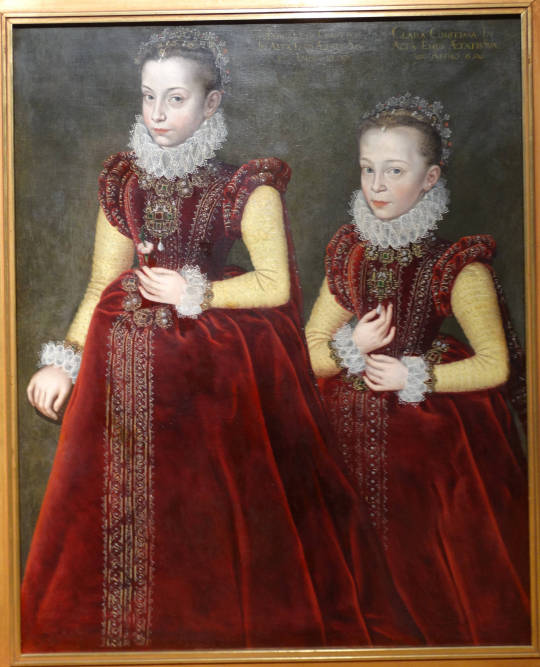
Markéta and Klára Hohenems by Anton Boys AKA Anthony Beys, 1577
#1577#1570s#16th century#mdp16th c.#austria#16th c. austria#holy roman empire#16th c. holy roman empire#Anton Boys#anthony beys
62 notes
·
View notes
Text

Colditz Castle
Colditz Castle is a Renaissance castle in the town of Colditz in the state of Saxony in Germany. The castle gained international fame as the site of Oflag IV-C, a prisoner-of-war camp during World War II for "incorrigible" Allied officers who had repeatedly escaped from other camps.
In 1046, Henry III of the Holy Roman Empire gave the burghers of Colditz permission to build the first documented settlement at the site. During 1083, Henry IV urged Margrave Wiprecht of Groitzsch to develop the castle site, which Colditz accepted. During the Middle Ages, the castle was used as a lookout post for the German Emperors and was the hub of the Reich territories of the Pleissenland. During 1504, the servant Clemens the baker accidentally set Colditz afire, and the town hall, church, castle and a large part of the town was burned. During 1506, reconstruction began and new buildings were erected around the rear castle courtyard. For nearly 100 years, from 1829 to 1924, Colditz was a sanatorium, generally reserved for the wealthy and the nobility of Germany. The castle thus functioned as a hospital during a long period of massive change in Germany. Between 1914 and 1918, the castle was home to both psychiatric and tuberculosis patients, 912 of whom died of malnutrition. When the Nazis gained power during 1933, they converted the castle into a political prison for communists, homosexuals, Jews and other people they considered undesirable. Starting 1939, allied prisoners were housed there.
After the outbreak of World War II, the castle was converted into a high security prisoner-of-war camp for officers who had become security or escape risks or who were regarded as particularly dangerous. Since the castle is situated on a rocky outcrop above the River Mulde, the Germans believed it to be an ideal site for a high security prison. The larger outer court, known as the Kommandantur, had only two exits and housed a large German garrison. The prisoners lived in an adjacent courtyard in a 90 ft (27 m) tall building. Although known as Castle Colditz to the locals, its official designation as a German military prison was Oflag IV-C and it was controlled by the Wehrmacht. While the camp was home to prisoners of war from many different countries, including Poland, France, Belgium, the Netherlands, and Canada, in May 1943 Wehrmacht High Command decided to house only British and American officers.
The camp's first British prisoners were the Laufen Six on November 7th, 1940, who were transferred to Colditz after their first escape attempt from the Laufen Camp. Although it was considered a high security prison, it had one of the greatest records of successful escape attempts. This could be owing to the general nature of the prisoners that were sent there; most of them had attempted escape previously from other prisons and were transferred to Colditz, because the Germans had thought the castle escape-proof. Captain Patrick R. Reid, who successfully escaped from Colditz in 1942, went on to write multiple works on the living conditions and various escape attempts at Colditz from 1940 to 1945: The Colditz Story and The Latter Days at Colditz. In the early 1970s, he served as a technical consultant for a BBC television series featuring David McCallum, Edward Hardwicke and Robert Wagner, that focused on life at Colditz.
During the last days of Colditz, many of its prominent or high-ranking prisoners were transferred to Laufen by order of Himmler. But in April 1945, U.S. troops entered the town of Colditz and, after a two-day fight, captured the castle on April 16th, 1945. In May 1945, the Soviet occupation of Colditz began. According to the agreement at the Yalta Conference it became a part of East Germany. The Soviets turned Colditz Castle into a prison camp for local burglars and non-communists. Later, the castle was a home for the aged and nursing home, as well as a hospital and psychiatric clinic. For many years after the war, forgotten hiding places and tunnels were found by repairmen, including a radio room established by the French POWs, which was then "lost" again only to be re-discovered some twenty years later.
During 2006 and 2007, the castle underwent a significant amount of refurbishment and restoration which was paid for by the state of Saxony. The castle walls were repainted to recreate the appearance of the castle prior to World War II. With renovations largely completed, the castle now includes both a museum and guided tours showing some of the escape tunnels built by prisoners of the Oflag during the war.
#world war 2#second world war#world war ii#german history#medival#castle#saxony#wwii#military history#location history
20 notes
·
View notes
Text
I don't like the song amazing grace or what it stands for in the context of african post-slavery cultural genocide juxtaposed with white western european colonialist christian values.
so like, african cultural heritage is what it is, right? it's heavily important to world history and obviously every ethnic group is valuable in its own way because humans are worthy of respect and stuff. that's a given.
so when slavery happened and the africans were stripped of their individuality and heritage and nationality and basically underwent mass cultural AND ethnic genocide. that fuckin sucks because a) slavery is bad and b) genocide is bad and c) being denied your birthplace and stuff is bad. I can't simplify this any further.
so what happened in history? many african slaves found solace in christianity and the bible because it gave them hope and distracted them from the hellish existence that is slavery. that continued throughout the generations past abolition through the civil rights movements and continues today. black christianity derived from slavery is the root of 90% of music we listen to today; it's heavily influential on today's cultural climate and the contributions of the black american cannot be denied. even now a significant portion of christianity in america is heavily attributed to african descended black people.
there's just one thing about that that really bothers me:
american christianity is heavily rooted in white western imperial european colonialism. oh no.
there are so many black christians with no idea where their ancestors lived or what cultural heritage they're derive from. they were robbed of their history. while white europeans have the privilege of being able to know so many things about their great great great etc grandparents. in this context white americans count because we're here because of european invasions. we can trace our lineage back for generations. so many of us know that we're 17% Italian or 17% Irish or 17% French or 17% Swedish n shit like that. most black americans don't know if their parents are part Kenyan or Ethiopian or Congo or Sudanese or whatever. that's why they refer themselves as black because all they have to go by is the color of their skin, because the people who owned their great great grandma sure as fuck didn't write down what country their slave came from because they didn't care because they treated black people as property because life was a godawful hellhole back then for most people. they don't get to know what country they're from like most white people do.
so when they turn to not only christianity but a specific form of christianity, protestant sects, it's like another step of cultural genocide. by embracing a religion created by white people to control minorities and women, regardless of how much they change it to make it their own, it's still rooted in the same bloody soil. they turn further from their own roots in the many different varying mythologies i can't talk much about because society values the mythology of nonblack people so much more: Greek, Norse, Egyptian (well the Egyptians were black but society loves to ignore that fact and whitewash them), Shinto, etc.
now I'm not saying that all black christians are directly responsible for participating in their own cultural genocide. that's an asinine claim. there are plenty of black jews, black muslims, black atheists, black pagans, black greek/norse/egyptian/shinto/etc followers, and surely there are lots of modern black euroamericans who still keep in touch with their cultural roots. the religious decisions of every individual are their own through mental autonomy and the ownership of their own consciousnesses.
what I AM saying is that christianity is a lot more insidious and evil than it appears to be on the surface. it was used as a defense of owning slaves- "africans deserve to be slaves because they're sons of ham, descended from the son of noah god cursed because the bible". it was used to protest abolition. it was used to uphold segregation. it was used to protest black votes. it's used to defend cops who kill unarmed men. it is, always has been, and always will be used as a weapon by white people against black existence. and the fact that throughout all of that, the exact same failed system of belief [speaking from a historical perspective of course because white christianity in the 16th century and beyond is massively poisoned by the bloated and corrupt papacy further than what it already was during the medieval and dark ages] was embraced so readily by the people that it oppressed...
it's just really concerning to me.
& it's not even a black thing. the prevalence of catholicism in mexican and other latin american culture is the same way. east asia is ripe with larger cultural superpowers eating the smaller ones and pretending they don't exist, just like china with taiwan, except not in a religious way. the holy roman empire did the same thing. and don't even get me started on the armenian genocide committed by the ottoman empire. and the fucking holocaust: hitler was christian. people say he wasn't a good christian since a good christian wouldn't try to kill the jews, the romani, the black, but are you sure about that? looking at all of history are you ABSOLUTELY SURE that white western imperialist european christian colonialism wouldn't try to murder everyone who didn't conform? naziism is on the rise again and it's masquerading as christianity. the president is a nazi and a christian.
no, this has nothing to do specifically with african and black populations and everything to do with christianity. except through "amazing grace" and its prevalence in that community.
also the man who wrote it manned slave ships. he was conscripted into it, became a slave in sierra leone for a while, and eventually became an abolitionist, but still :/ imagine if rommel the kraut of africa wrote a song and a hundred years later it became a celebrated jewish hymn. that would be incredibly fucked up and wrong.
but whatever, maybe I'm looking too far into this, maybe there's no illuminati boogeyman trying to erase black and jewish culture from world history, maybe it's all just a big goddamn coincidence that the victims of colonialism embraced the religion that the imperials used. ¯\_(ツ)_/¯ maybe just maybe it's a fucking fluke.
anyway black people can like the song if they want. they can be christians.
I just hate the song and won't be a christian. you do you and I'll do me and we'll all get along happily.
1 note
·
View note
Photo
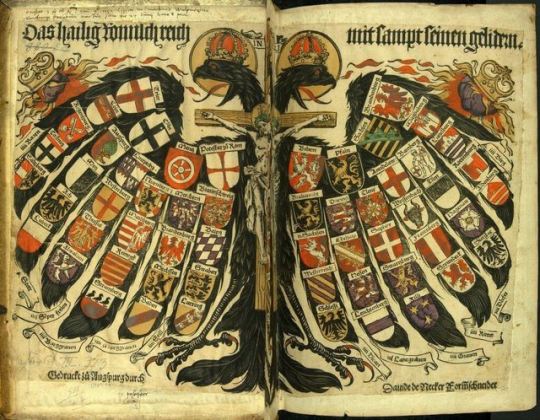





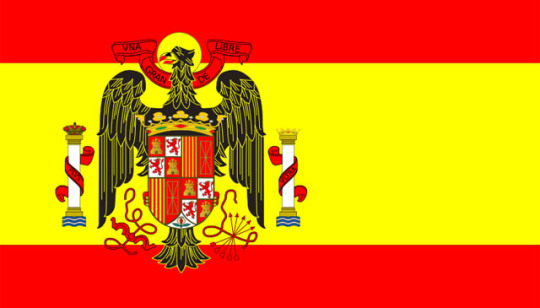



“The earliest depiction of the double-headed eagle can be found on ancient on Hittite monuments in central Anatolia. In the early 19th century, in Boğazkale, an old Hittite capital in modern-day Turkey...The double-headed eagle motif originally dates from c. 3800 BC. The Hittites had worshiped the double headed eagle as the King of Heaven, who was also called the Hittite Bird of the Sun. The bird was their symbol to signify Hittite military power.”

”The bird bird appears in Lygash under the name of Imgig, and was the Sumerian symbol for the god of Lagash, Ninurta son of Enlil...the double-headed eagle, however, is not restricted to supporting deities, and also appears supporting human figures. This is an indication of the use of the eagle as a personal (or family) symbol...The Seliuk Turks referred to it as Hamca and among the Zuni it appeared as a highly conventionalized design, but still as a double-headed thunder bird, the Sikyatki.”

”The double-headed eagle has been used as an emblem by countries, nations, and royal houses in Europe since the early medieval period. Notable examples include the Byzantine House of Palaiologos, the Holy Roman Empire, the House of Habsburg, and the Ruriks and Romanovs of Russia. The symbol often appears on countries’ coats of arms and flags. The emblem was adopted by the Russians, Poles, Serbians, Prussians, Austrians and Saxons. It was used as a private seal and as arms in Germany, Spain, France, Netherlands, England, and Russia.”
(via Mystery Of The Ancient Double-Headed Eagle Symbol | Locklip)
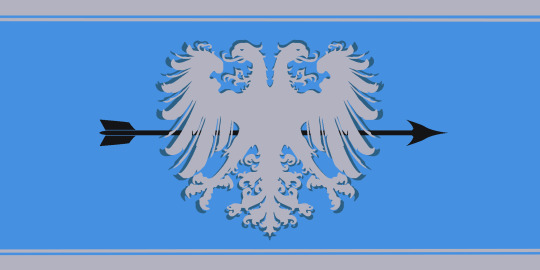
Double Headed Eagle iconology of Byzantium
“Greek scholars have tried to make links with ancient symbols: the eagle was a common design representing power in ancient city-states, while there was an implication of a "dual-eagle" concept...However, there is virtually no doubt that its origin is a blend of Roman and Eastern influences. Indeed, the early Byzantine Empire inherited the Roman eagle (extended wings, head facing right) as an imperial symbol.”

“[T]he church of Greece kept, and is to this date still using Byzantine flags with the eagle, usually black on yellow/gold background. But after the Ottoman conquest this symbol also found its way to a "new Constantinople" (or Third Rome), i.e. Moscow. Russia, deeply influenced by the Byzantine Empire, saw herself as its heir and adopted the double-headed eagle as its imperial symbol. It was also adopted by the Serbs, the Montenegrins, the Albanians and a number of Western rulers, most notably in Germany and Austria.”
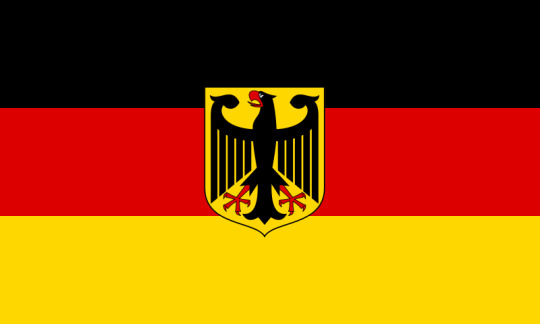
“The first mention of a double-headed eagle in the West dates from 1250 in a roll of arms of Matthew of Paris for Emperor Friedrich II. Theodore II Laskaris chose it for his symbol as Emperor (Empire of Nicaea), taking it to symbolize his state's claims to all the Byzantine Empire's former domains, both European (West) and Asian (East)... After the recapture of Constantinople and the restoration of the Byzantine Empire, the symbol was used as an emblem of the imperial family, but it is uncertain whether it was the official emblem of the Empire.”

“The double-headed eagle became the standard of the Seljuk Turks with the crowning of Toghrül (meaning "Eagle") Beg at Mosul in 1058 as "King of the East and the West" and was much used afterwards. The Sultans of Rum, Ala ad-Din Kay Qubadh I (1220-1237) and his son Kay Khusrau II (1237-1246) used the bicephalous eagle in their standards, and the motif was also found on tissues, cut stones, mural squares, and Koran holders.”
(via Double Headed Eagle iconology of Byzantium | Kythera Family blog)

The double-headed eagle of the Third Rome
“When looking carefully, you can distinguish 9 coats of arms on the eagle. However, in most cases, these shields are printed so tiny that few details can be revealed. The center shield on the eagle's chest is the one with the arms of Moscow. Then, in clockwise order starting from the heads, we see the arms of [Khanate of] Astrakhan, [Khanate of] Siberia, [Kingdoms & Principalities of] Georgia, [Grand Duchy of] Finland, [Grand Principalities of] Kiev-Vladimir-Novgorod, [Khanate of] Taurica, [Kingdom of] Poland and [Khanate of] Kazan...this double-headed eagle represents about 500 years of Russian imperial history.”
(via The double-headed eagle of the Third Rome | Franky’s Scripophily BlogSpot)
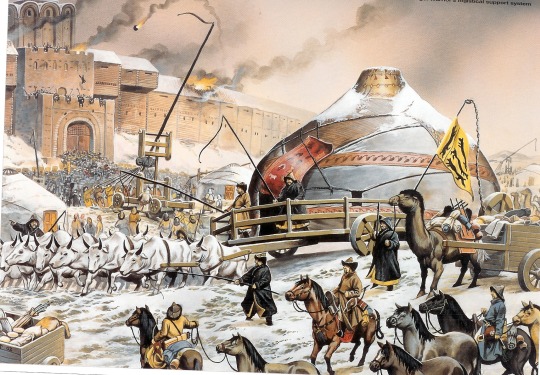
Kiev and the Byzantine Legacy in Russia
“The history of Kiev begins under the rule of the Rus. The Rus (also known as Varangians) were original Vikings who began to trade along the Volga River and later the Dnieper River. They establish several principalities centered on cities like Novgorod and later Kiev...Vladimir was also among the rulers of Kiev who gave military assistance to the Byzantines, leading to the formation of the Varangian Guard...Saint Sophia's Cathedral in Kiev, which dates to the early 11th century. It was designed rival Hagia Sophia in Constantinople, thus symbolizes Kiev as the 'new Constantinople'. There was even a Golden Gate in Kiev, named after the famous Golden Gate of Constantinople. In addition, the Kiev Monastery of the Caves date to 1051 and were influential in the spread of Orthodox thought.“
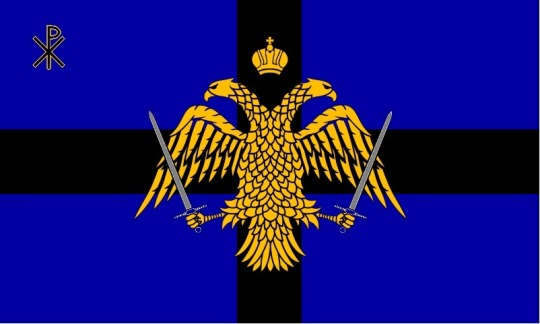
“As the Byzantine Empire was slowly dying, Moscow began to grow in power. The Metropolitan of Kiev moved to Moscow in the 14th century as the Tatars undermined the power of Kiev. Ivan III (1440-1505), the Grand Prince of Moscow, ended the dominance of the Golden Horde in Russia, and became to expand his own power. In 1472, He married Sophia Palaiologina, the niece of the last Byzantine Emperor, after the fall of Constantinople. He would then claim that Moscow was the “Third Rome” and by the end of the 16th century, the Metropolitan of Moscow claimed the title of patriarch. The title Tsar also reflects this claim to be the successor of Constantinople. In fact, the Russian Empire’s symbol was the Byzantine Double Eagle until the Soviet’s overthrew Tsar Nicholas II. This symbol has since returned after the fall of the Soviet Union.“

Mongol-Papal Encounter: Letter Exchange between Pope Innocent IV and Güyük Khan in 1245-1246
“By the late 1230s, Mongol armies had begun raiding parts of Russia and eastern Europe. Between 1236 and 1242, these military campaigns–commanded by Subutai (d. 1248), Batu Khan (d. 1255), and Berke (d. 1266), among others–had wrought major devastation across Russia, Poland, Hungary and the Balkans. The cities of Kiev, Pereyaslavl, Chernihiv, Lublin, and other major population centers in eastern and central Europe were sacked and their populations massacred.”
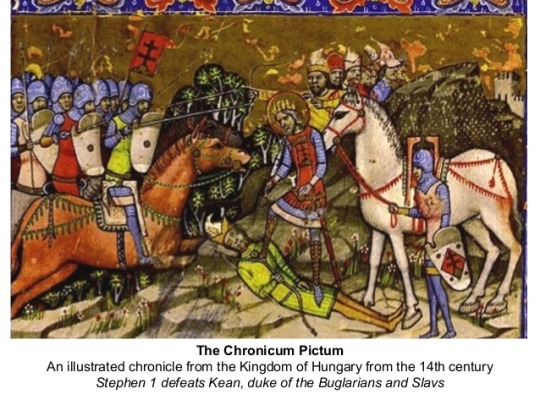
“The defeats of the Polish forces at the Battle of Liegnitz/Legnica (April 9th 1241) and the Hungarian military at the Battle of Mohi (April 11th 1241) opened up most of the Balkans and Central Europe to Mongol raids, leading to even more destruction, displacement and massacres. These alarming developments shook the foundations of Latin Christendom. Although the Mongols withdrew from most of the Balkans and east-central Europe soon after”
(via Mongol-Papal Encounter: Letter Exchange between Pope Innocent IV and Güyük Khan in 1245-1246 | Ballandalus blog)
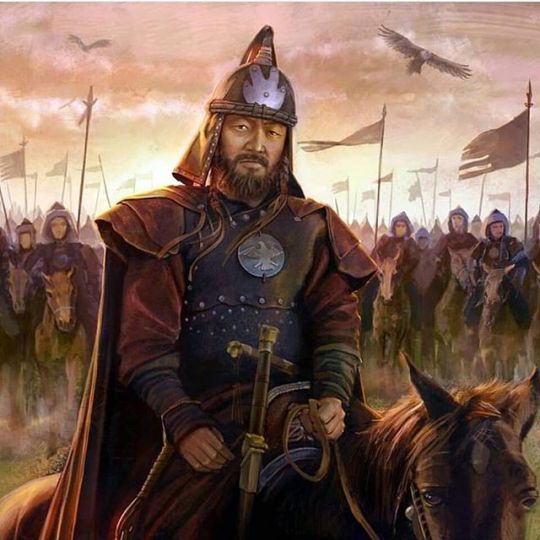
Borjigin
“A Borjigin or Borjigid is a member of the sub-clan, which started with Yesugei (but the Secret History of the Mongols makes it go back to Yesugei's ancestor Bodonchar), of the Kiyat clan. Yesugei's descendants were thus said to be Kiyat-Borjigin. The senior Borjigid provided ruling princes for Mongolia and Inner Mongolia until the 20th century. The clan formed the ruling class among the Mongols and some other peoples of Central Asia and Eastern Europe.”
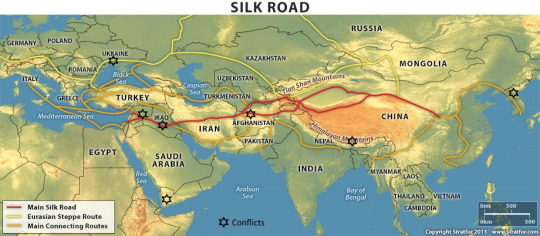
“The Borjigin family ruled over the Mongol Empire from the 13th to 14th century. The rise of Genghis (Chingis) narrowed the scope of the Borjigid-Kiyad clans sharply. This separation was emphasized by the intermarriage of Genghis's descendants with the Barlas, Baarin, Manghud and other branches of the original Borjigid.”

”In the western regions of the Empire, the Jurkin and perhaps other lineages near to Genghis's lineage used the clan name Kiyad but did not share in the privileges of the Genghisids. The Borjigit clan had once dominated large lands stretching from Java to Iran and from Indo-China to Novgorod. In 1335, with the disintegration of the Ilkhanate in Iran, the first of numerous non-Borjigid-Kiyad dynasties appeared. Established by marriage partners of Genghisids, these included the Suldus Chupanids, Jalayirids in the Middle East, the Barulas dynasties in Chagatai Khanate and India, the Manghud and Onggirat dynasties in the Golden Horde and Central Asia, and the Oirats in western Mongolia.In 1368, under Toghun Temür, the Yuan dynasty was overthrown by the Ming dynasty in China but members of the family continued to rule over Mongolia homeland into the 17th century, known as the Northern Yuan dynasty.”

“After the breakup of the Golden Horde, the Khiyat continued to rule the Crimea and Kazan until the late 18th century. They were annexed by the Russian Empire and the Chinese...The Qing dynasty respected the Borjigin family and the early emperors married the Hasarid Borjigids of the Khorchin. Even among the pro-Qing Mongols, traces of the alternative tradition survived. Aci Lomi, a banner general, wrote his History of the Borjigid Clan in 1732–35. The 18th century and 19th century Qing nobility was adorned by the descendants of the early Mongol adherents including the Borjigin.”

“Genghis Khan founded the Mongol Empire in 1206. His grandson, Kublai Khan, after defeating his younger brother Ariq Böke, founded the Yuan dynasty in China in 1271. The dynasty was overthrown by the Ming dynasty during the reign of Toghaghan-Temür in 1368, but it survived in Mongolia homeland, known as the Northern Yuan dynasty.”

Bahri dynasty
“The Bahri dynasty or Bahriyya Mamluks was a Mamluk dynasty of mostly Cuman-Kipchak Turkic origin that ruled the Egyptian Mamluk Sultanate from 1250 to 1382. They followed the Ayyubid dynasty, and were succeeded by a second Mamluk dynasty, the Burji dynasty."
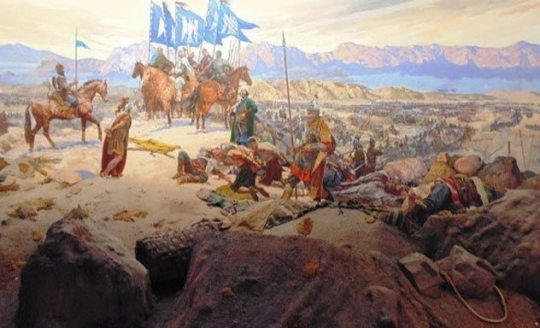

Burji dynasty
“From 1250 Egypt had been ruled by the first Mamluk dynasty, the mostly Cuman-Kipchak Turkic Bahri dynasty. In 1377 a revolt broke out in Syria which spread to Egypt...Barquq was proclaimed sultan in 1382, ending the Bahri dynasty...Permanently in power, he founded the Burji dynasty.”

House of Borghese
“Borghese is the surname of a princely family of Italian noble and papal background, originating as the Borghese or Borghesi in Siena, where they came to prominence in the 13th century holding offices under the commune. The head of the family, Marcantonio, moved to Rome in the 16th century and there, following the election (1605) of his son Camillo as Pope Paul V they rose in power and wealth. They were one of the leading families of the Black Nobilityand maintain close ties to the Vatican.”

Guelphs and Ghibellines
“The Guelphs and Ghibellines were factions supporting the Pope and the Holy Roman Emperor, respectively, in the Italian city-states of central and northern Italy. During the 12th and 13th centuries, rivalry between these two parties formed a particularly important aspect of the internal politics of medieval Italy.”

”The names were likely introduced to Italy during the reign of Frederick Barbarossa. When Frederick conducted military campaigns in Italy to expand imperial power there, his supporters became known as Ghibellines (Ghibellini). The Lombard League and its allies were defending the liberties of the urban communes against the Emperor's encroachments and became known as Guelphs (Guelfi). The Ghibellines were thus the imperial party, while the Guelphs supported the Pope. Broadly speaking, Guelphs tended to come from wealthy mercantile families, whereas Ghibellines were predominantly those whose wealth was based on agricultural estates.”
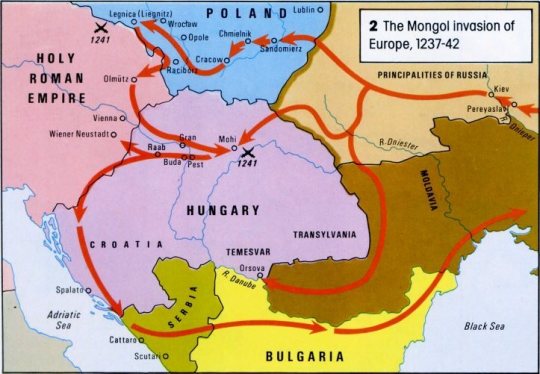
Frederick II, Holy Roman Emperor
“In 1241–1242, the forces of the Golden Horde decisively defeated the armies of Hungary and Poland and devastated their countryside and all their unfortified settlements. King Béla IV of Hungary appealed to Frederick for aid, but Frederick, being in dispute with the Hungarian king for some time (as Bela had sided with the Papacy against him) and not wanting to commit to a major military expedition so readily, refused. He was unwilling to cross into Hungary, and although he went about unifying his magnates and other monarchs to potentially face a Mongol invasion, he specifically took his vow for the defense of the empire on "this side of the Alps."

”Frederick was aware of the danger the Mongols posed, and grimly assessed the situation, but also tried to use it as leverage over the Papacy to frame himself as the protector of Christendom. While he called them traitorous pagans, Frederick expressed an admiration for Mongol military prowess after hearing of their deeds, in particular their able commanders and fierce discipline and obedience, judging the latter to be the greatest source of their success. He called a levy throughout Germany while the Mongols were busy raiding Hungary. In mid 1241 Federick dispersed his army back to their holdfasts as the Mongols preoccupied themselves with the lands east of the Danube, attempting to smash all Hungarian resistance. He subsequently ordered his vassals to strengthen their defenses, adopt a defensive posture...A chronicler reports that Frederick received a demand of submission from Batu Khan at some time.”
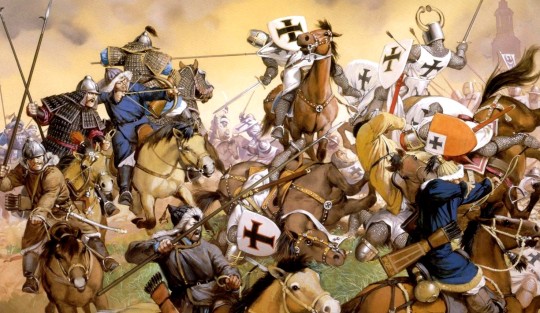
“A letter written by Emperor Frederick II, found in the Regesta Imperii, dated to June 20, 1241, and intended for all his vassals in Swabia, Austria, and Bohemia, included a number of specific military instructions. His forces were to avoid engaging the Mongols in field battles, hoard all food stocks in every fortress and stronghold, and arm all possible levies as well as the general populace.
Mongol probing attacks materialised on the Holy Roman Empire's border states...A full-scale invasion never occurred, as the Mongols spent the next year pillaging Hungary before withdrawing. After the Mongols withdrew from Hungary back to Russia, Frederick turned his attention back towards Italian matters.”

Pope Innocent IV
“In 1245, Innocent IV issued bulls and sent an envoy in the person of Giovanni da Pian del Carpine (accompanied by Benedict the Pole) to the "Emperor of the Tartars". The message asked the Mongol ruler to become a Christian and stop his aggression against Europe. The Khan Güyük replied in 1246 in a letter written in Persian that is still preserved in the Vatican Library, demanding the submission of the Pope and the other rulers of Europe...two Mongolian envoys to the Papal seat in Lyon, Aïbeg and Serkis. In the letter Guyuk demanded that the Pope appear in person at the Mongol imperial headquarters, Karakorum in order that “we might cause him to hear every command that there is of the jasaq”.
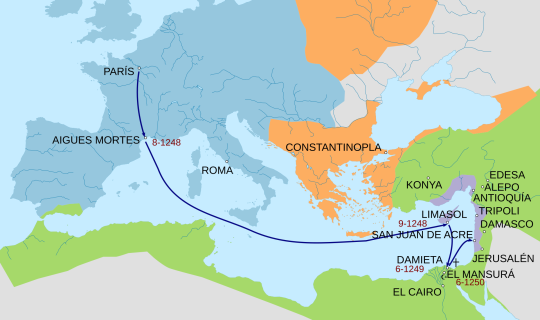
Seventh Crusade
“In 1244, the Khwarezmians, recently displaced by the advance of the Mongols, took Jerusalem on their way to ally with the Egyptian Mamluks. This returned Jerusalem to Muslim control, but the fall of Jerusalem was no longer a crucial event to European Christians, who had seen the city pass from Christian to Muslim control numerous times in the past two centuries. This time, despite calls from the Pope, there was no popular enthusiasm for a new crusade. There were also many conflicts within Europe that kept its leaders from embarking on the Crusade.”
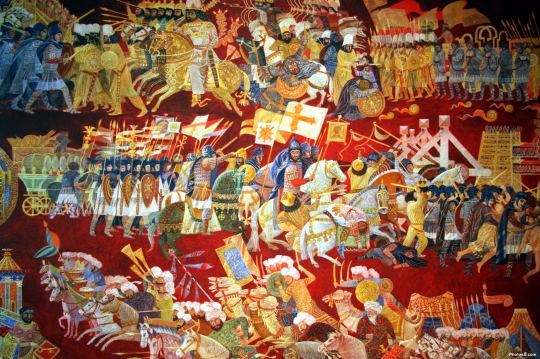
“Pope Innocent IV and Frederick II, Holy Roman Emperor continued the papal-imperial struggle. Frederick had captured and imprisoned clerics on their way to the First Council of Lyon, and in 1245 he was formally deposed by Innocent IV. Pope Gregory IX had also earlier offered King Louis' brother, count Robert of Artois, the German throne, but Louis had refused. Thus, the Holy Roman Emperor was in no position to crusade. Béla IV of Hungary was rebuilding his kingdom from the ashes after the devastating Mongol invasion of 1241.”
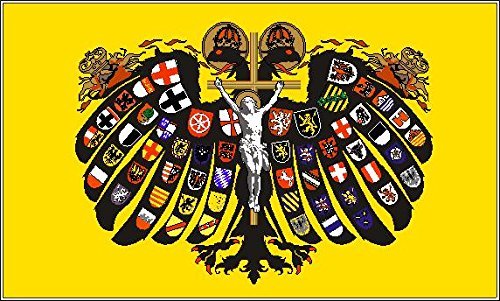
Interregnum (Holy Roman Empire)
“The term Great Interregnum is occasionally used for the period between 1250 (death of Frederick II) and 1273 (accession of Rudolf I)...After the deposition of Frederick II by Pope Innocent IV in 1245...in 1273, Rudolf I of Germany, a minor pro-Staufen count, was elected. He was the first of the Habsburgs to hold a royal title, but he was never crowned emperor. After Rudolf's death in 1291, Adolf and Albert were two further weak kings who were never crowned emperor...Sigismund (r. 1411 – 1437) was crowned emperor in 1433, but only with Frederick III (r. 1452 – 1493), the second emperor of the House of Habsburg, did the Holy Roman Emperor return to an unbroken succession of emperors (with the exception of Charles VII all of the House of Habsburg) until its dissolution in 1806.”

Franco-Mongol alliance
“European attitudes began to change in the mid-1260s, from perceiving the Mongols as enemies to be feared, to potential allies against the Muslims. The Mongols sought to capitalize on this, promising a re-conquered Jerusalem to the Europeans in return for cooperation. Attempts to cement an alliance continued through negotiations with many leaders of the Mongol Ilkhanate in Persia, from its founder Hulagu through his descendants Abaqa, Arghun, Ghazan, and Öljaitü, but without success. The Mongols invaded Syria several times between 1281 and 1312, sometimes in attempts at joint operations with the Franks, but the considerable logistical difficulties involved meant that forces would arrive months apart, never able to coordinate activities in any effective way...the Egyptian Mamluks successfully recaptured all of Palestine and Syria from the Crusaders.”
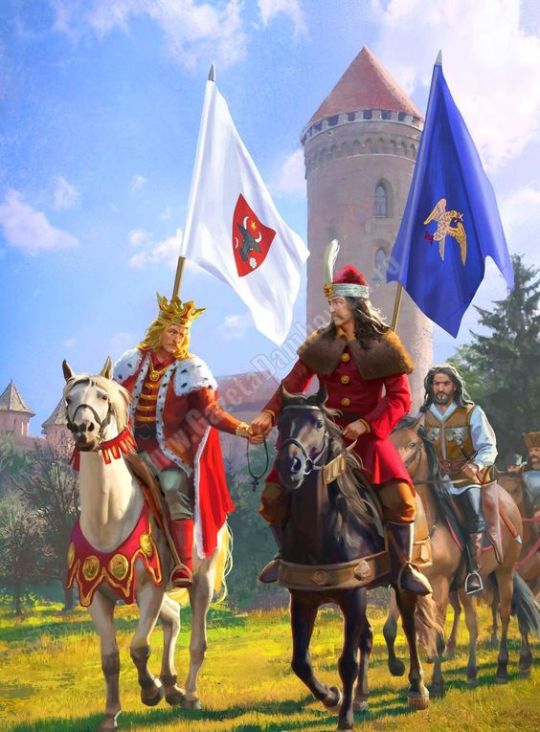
“Christian kings began to prepare for a new crusade (the Seventh Crusade), declared by Pope Innocent IV in June 1245 at the First Council of Lyon. The loss of Jerusalem caused some Europeans to look to the Mongols as potential allies of Christendom, provided the Mongols could be converted to Western Christianity. In March 1245, Pope Innocent IV had issued multiple papal bulls, some of which were sent with an envoy, the Franciscan John of Plano Carpini, to the "Emperor of the Tartars". In a letter now called the Cum non solum, Pope Innocent expressed a desire for peace, and asked the Mongol ruler to become a Christian and to stop killing Christians. However, the new Mongol Great Khan Güyük, installed at Karakorum in 1246, replied only with a demand for the submission of the pope, and a visit from the rulers of the West in homage to Mongol power:”

Hohenstaufen
“The Hohenstaufen also known as Staufer, were a dynasty of German kings (1138–1254) during the Middle Ages. Before ascending to the kingship, they were Dukes of Swabia from 1079. As kings of Germany, they had a claim to Italy, Burgundy and the Holy Roman Empire. Three members of the dynasty—Frederick I (1155), Henry VI (1191) and Frederick II (1220)—were crowned emperor. Besides Germany, they also ruled the Kingdom of Sicily (1194–1268) and the Kingdom of Jerusalem (1225–1268) [succeeded by the House of Habsburg in 1268]”
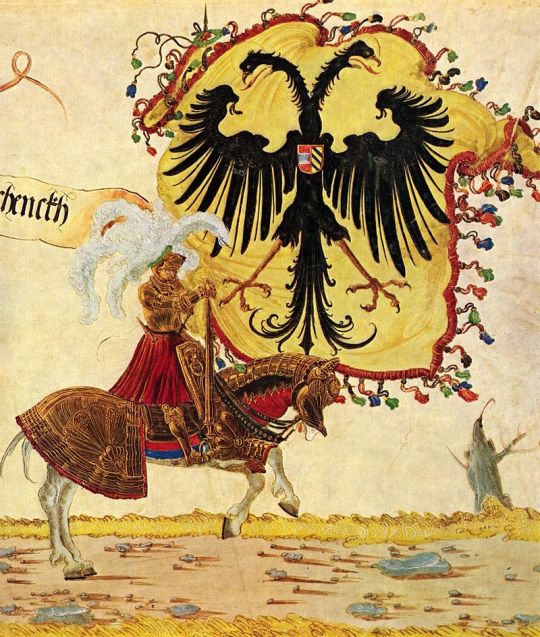
House of Habsburg
“The House of Habsburg and alternatively called the House of Austria was one of the most influential and distinguished royal houses of Europe. The throne of the Holy Roman Empire was continuously occupied by the Habsburgs from 1438 until their extinction in the male line in 1740. The house also produced emperors and kings of Bohemia, Hungary, Croatia, Galicia, Portugal and Spain with their respective colonies, as well as rulers of several principalities in the Netherlands and Italy.”

“The Habsburg Empire was never composed of a single unified and unitary state as Bourbon France, Hohenzollern Germany, or Great Britain was. It was made up of an accretion of territories that owed their historic loyalty to the head of the house of Habsburg as hereditary lord. The Habsburgs had mostly married the heiresses of these territories, most famously of Spain and the Netherlands. They used their coats of arms then as a statement of their right to rule all these territories."
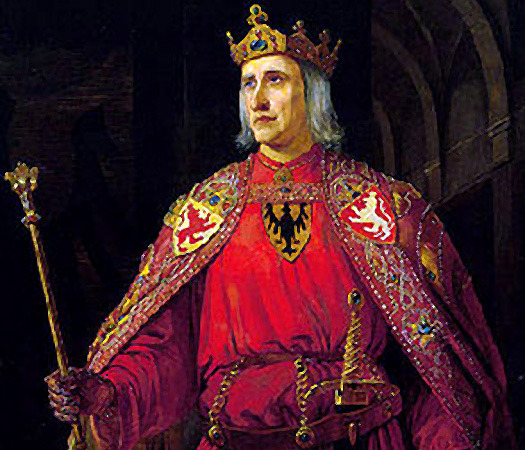
Rudolf I of Germany
“Rudolf I, also known as Rudolf of Habsburg was Count of Habsburg from about 1240 and King of Germany from 1273 until his death.Rudolf's election marked the end of the Great Interregnum in the Holy Roman Empire after the death of the Hohenstaufen emperor Frederick II in 1250.
The disorder in Germany during the interregnum after the fall of the Hohenstaufen dynasty afforded an opportunity for Count Rudolf to increase his possessions. His wife was a Hohenberg heiress; and on the death of his childless maternal uncle Count Hartmann IV of Kyburg in 1264, he also seized his valuable estates.”

Kyburg family
“Kyburg also Kiburg was a noble family of grafen (counts) in the Duchy of Swabia, a cadet line of the counts of Dillingen, who in the late 12th and early 13th century ruled the County of Kyburg, corresponding to much of what is now Northeastern Switzerland.The family was one of the four most powerful noble families in the Swiss plateau beside the House of Habsburg, House of Zähringen and the House of Savoy during 12th century. With the extinction of the Kyburg family's male line in 1264, Rudolph of Habsburg laid claim to the Kyburg lands and annexed them to the Habsburg holdings, establishing the line of "Neu-Kyburg", which was in turn extinct in 1417.”
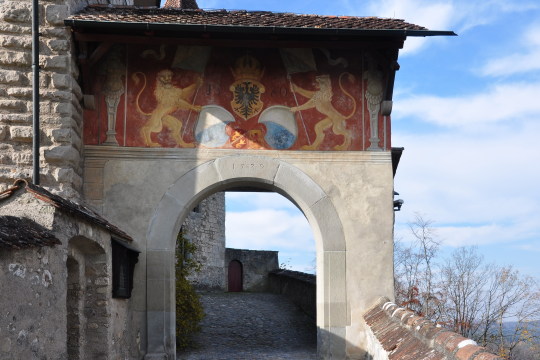
“In 1250/51 the childless Hartmann IV gave the western part of the property with the center of Burgdorf to his nephew Hartmann V. As a result, Hartmann V, who was supported by the Habsburgs, came into conflict repeatedly with the growing city-state of Bern. His uncle had to step in often to keep the peace. When Hartmann V died in 1263, Count Rudolf von Habsburg became the guardian of Hartmann's daughter Anna, and also took over the administration of the western section. In 1264, after the death of Hartman IV, Rudolf stepped in to control the eastern half as well. Though this brought him into conflict with the claims by the widow Margaret of Savoy and her family.”

”Anna, daughter of Hartmann V, married Eberhard I of Habsburg-Laufenburg. This marriage was intended to secure Habsburg interests in Aargau (Argovia) against Savoy. The son of Eberhard and Anna, Hartmann I (1275–1301) again called himself "of Kyburg". His line came to be known as that of Neu-Kyburg or Kyburg-Burgdorf, persisting until 1417.”

House of Borgia
“The House of Borgia was an Italo-Spanish noble family, which rose to prominence during the Italian Renaissance. They were from Aragon, the surname being a toponymic from the town of Borja, then in the Crown of Aragon, in Spain.The Borgias became prominent in ecclesiastical and political affairs in the 15th and 16th centuries, producing two popes: Alfons de Borja, who ruled as Pope Callixtus III during 1455–1458, and Rodrigo Lanzol Borgia, as Pope Alexander VI, during 1492–1503.”

Name of Turkey
“The English name Turkey, now applied to the modern Republic of Turkey, is historically derived (via Old French Turquie) from the Medieval Latin Turchia, Turquia. It is first recorded in Middle English (as Turkye, Torke, later Turkie, Turky), attested in Chaucer, ca. 1369. The Ottoman Empire was commonly referred to as Turkey or the Turkish Empire
The English name of Turkey (from Medieval Latin Turchia/Turquia) means "land of the Turks"...The phrase land of Torke is used in the 15th-century Digby Mysteries. Later usages can be found in the Dunbar poems, the 16th century Manipulus Vocabulorum ("Turkie, Tartaria")...The medieval Greek and Latin terms did not designate the same geographic area now known as Turkey. Instead, they were mostly synonymous with Tartary, a term including Khazaria and the other khaganates of the Central Asian steppe, until the appearance of the Seljuks and the rise of the Ottoman Empire in the 14th century...The Arabic cognate Turkiyya (Arabic: تركيا) in the form Dawla al-Turkiyya (State of the Turks) was historically used as an official name for the medieval Mamluk Sultanate which covered Egypt, Palestine, Syria, Hejaz and Cyrenaica.”

What’s the Word for Turkey in Turkish?
“The word for turkey in Turkish is hindi.What? OK, so what’s the Hindi word for turkey?Turns out that the word for turkey in Hindi is टर्की. And that, if you don’t know Devanagari, is transcribed ṭarkī in the Latin alphabet.
Turkeys are native to the Americas, but the Europeans first encountering them thought that they looked like a kind of guinea fowl, another large, ungainly, colorful-faced kind of bird. Now, guinea fowl were also called turkey fowl, but that’s because they actually had a legitimate connection to Turkey the country: Europeans received most of their guinea fowl imported via Turkey...the first turkeys brought to Europe also generally came via Turkey: The birds had originally been domesticated by the Aztecs and were brought to Europe by Spanish conquistadores, who traded them to the rest of the continent via North Africa.
Japanese and Korean call it the equivalent of “seven-faced bird,” Abkhazian and other languages in the Caucasus call it “blue bird,” and Thai and Urdu call it “elephant chicken” or “elephant trunk chicken.”

(via What’s the Word for Turkey in Turkish? | Slate)
#turkey#silkroad#chainofcommerce#noblemerchantclans#ambasadorsorspies#kiyat#borjigin#burji#borgia#borghese#kiburg#ghibelines#holyromanempire#rudolfofhapsburg#hapsburgdynasty#vladtheimpaler#transylvania#house of saxe-coburg and gotha#popeinnocentiv#guyukkhan#mongolultimatum#marriagealliance#tributetax#wagewarfortribute#secrethistoryofthemongols#doubleheadedeagle#goldenhorde#goldenorder
13 notes
·
View notes
Text
Skyler Whitenack - Rockford Man
Details about the Whitenack family living in Adelshofen was available in action to an ad in the November, 1963 issue of Archiv fur Sippenforschung which was placed by Mr. von Frank.
He believed there might be discovered in the State Archives of Baden which would include records of feudal estates, tax payments, and so on. The records are not indexed so many packages of records would have to be gone through.
Originally Rockford market was based on 2 locaI basic materials: wheat for flour mills and lumber for saw mills. Both resources have actually disappeared from the area. Flour mills paved the way to other industries which took their put on the waterpower they had helped develop. Saw mills provided method to wood working plants which now must reach numerous miles into Canada and Appalachia for basic materials.
Much of the Palatinate was church land. In 1446 Germany was a federation ruled by ecclesiastical princes acknowledging fealty to the Holy Roman Empire. Damage of the Hohenstaufen dynasty by the popes of the 13th century had actually damaged the Holy Roman Empire and in 1400 it was a loose association of Germany, Austria, Bohemia, Holland ans Switzerland. Carinthia was mining gold as early as 1300, in 1519 it was west of Hungary and east of Switzerland and the Tyrol. Styria was just above Carinthia. Styria and lower Austira was ravaged by the Turks in 1532. In 1517 a league of 90,000 peasants in Styria and Carinthia carried out to end feudalism there and they attacked castles and slew their lords. In the Revolt in Alsace of 1562, 20,000 peasants were killed. Peasants had ruined hundreds of castles, abbeys, villages were depopulated and destroyed. Peasants wandered the highways and concealed in the woods.
Records of the Weidknecht's were discovered in Regensburg, Baden and Alsace. Baden was a margraviate in 1689.
A very little part of the output of Rockford's hardware factories is taken by her furniture factories, however most of the hardware is marketed in other places, especially in the east. Regional foundries supply metal producers with castings, but once again much of the production is offered in other areas. One furnishings factory focuses on stitching maker cabinets and actually has been acquired by a sewing device company. A slight fraction of the device tool output goes to Rockford metal fabricators. Nevertheless, the correlations between Rockford factories as sources of basic materials, devices, or markets for each other is minor. Rockford's industry makes use of basic materials which, in basic, are obtained from factories in the East; her industry serves a market which, though across the country, also is focused in the East.
In some town in the Palatinate the parochial signs up started in 1691 however the Lutheran registers did not start till 1727 or later on. A history of Alsace, Baden, Speyer, Heidelberg and Mannheim reveals that in 1689 the French Army sacked and burned hundreds of towns, hence records of the occupants would have been ruined. In 1659 Spain signed the Peace of the Pyrenees and deserted all claim to Alsace, ceding it to France. France ended up being the most effective nation in Europe. Louis XIV was the ruler in France. The French generals complied with Louis XIV and revealed to the residents of the above prospering German towns to evacuate their castles and towns as they were to be ruined by fire and sword.
In the 16th century, Bavaria included: Munich, Regensburg and Salzburg. Swabia consisted of: Baden, Stuttgart, Augsburg and Wurttemberg. Upper Rhine consisted of: Frankfurt am Main, Cassel, Darmstadt, Wiesbaden, Hesse and part of Alsace.
Although the Whitenacks were living in Baden, Alsace and Regensburg in the 1600's, they may have initially been from lower Austria or most any place in Europe.
I am revealing the very first generations referred to as Family No. 1, Family No. 2, Family No. 3, then In America calling the numerous households A, B, C, etc. If you need to know just how numerous generations have actually been traced, discover <missing the remainder of the sentence> ... Family No. 1.
Martin Weidknecht, burgomaster of Adelshofen, (district Sinsheim, in the Kraichgau, Baden) (village of about 200 homes, some very old with stables connected to your homes). Martin Weidknecht was born about 1601 and died June 24, 1671, age 70 when he passed away; married before 1633 to Barbara--, who was born about 1607 and died December 25, 1687 in Adelshofen, 80 years of ages when she passed away. Problem:
Johann Martin Weidknecht, born about 1633 who passed away Dec. 6, 1688 in Adelshofen.
Household No. 2
He married (1 ): Catherina Weidknecht, the daughter of Hans Weidknecht, resident of Adelshofen who was born about 1619/20 and died Feb. 18, 1670, age 50 who wed prior to 1641 Catherina--, born about 1611 and died August 17, 1679 in Adelshofen. Andreas Weidknecht first marital relationship to Catherina Weidknecht was no Nov. 14, 1671 (she was born about 1648 and died Nov. 12, 1675 in Adelshofen.
Andreas Weidknecht wed (2) Anna Elisabetha Schlà 1/4 tter on July 25, 1677 in Adelshofen who was born about 1653 and she passed away Oct. 24, 1738. Issue by this marital relationship:
The first record of Johannas Wietkneght then is that he joined the church at Readington (North Branch,) N. J. in 1728. He was on the tax list of 1735 in Franklin, (called 6-Mile Run in 1716) Somerset Co., N.J. as owning 100 acres of land, livestock 7, and was taxed  ₤ 1 1s 3d. Hw was a freeholder (of land) in the Sourland Mountain (Western Precinct) in 1753 and a member of Mr. Frelinghuysen's church at 6-Mile Run and was voted a senior of the church on Sept. 25, 1751. In 1761 he contributed  ₤ 0.10 s 0 to build the kerk at Neshanneck. Solutions were in English and Dutch until 1784.
<img src="https://pixabay.com/get/55e3d3454d50b108f5d08460962b3378133adbe64e50744f7c297fdc9248c0_640.jpg" width="640" height="425" />
Whiteanack, Bleker.
Whitenack, John.
Whitnack, Abraham.
Whitnack, Andries.
Whitnack, Benjamin.
Northampton county, Pa., Bethlehem Twsp., Mathias Weidkneght was taxed for 100 acres of land, 3 horses and 2 cattle in 1785, 86 and 88.
In a list of Revolutionary War Veterans, Morris Co., N.J. the following were discussed:.
Household No. B-10:.
( Youngest kid of Blakert Whitenack) John Whitenack (Whitekanack) Sr. of Morris Co., N.J. His will was dated Mar. 16, 1799 and proved Feb 8, 1800 (Lib. 39, page 97 File 1052 M) Yeoman. Spouse, Rachel, to have house, furnishings and use of plantation while a widow. Earliest kid, Thomas, all genuine after other half's decease or marriage. Needs to Thomas die without problem, then divide in between boys: William and Peter. Sons: William and Peter  ₤ 50 each. Children: Phebe, Charity, Elizabeth, Susannah, Catarine and Ruth each 20 shillings. Executed by boy, Thomas. Witness: Philip Parker, Samuel Hawes, and John Bockoven. This John Whitekanack is thought to be Bliker Whitnek's youngest boy, who wed Oct. 12, 1773 in Sussex Co. He may be the John Whitenack who remained in the Revolutionary War (Sussex Co.). His son Peter was most likely the Sergeant Peter Whitenack who registered 7 Sept. 1814 in War of 1812 and was released 4 Dec. 1814.
Andreas Weidknecht, his spouse Margretha and 3 children came to America in 1709. They joined the fantastic Palatinate emmigration from Germany to England in 1709. Some authorities declare there were 2,000 and others 32,000 in the group. Not all of them concerned America; soe went to Ireland. Reason for emmigration: thirty years war devastated Palatinate region, greater and higher taxes to support rulers of Germany in high-end, extremem cold winter of 1709 - birds on the wing fell dead, wind in casks froze solid, etc. There were 6 cruisings of Palatinates to America, the very first four boats carried very bad emmigrants who were unable to pay for their passage. The names of the travelers on the very first 4 ships is offered however the Weidknecht family was not noted. The last two ships guests were for the most part tradespersons and spent for their own passage. The last boat did not show up till August 2, 1710 in America. They were all packed with disease obtained on shipboard so they were quarantined for 5 months on Nutten Island now called Governor's Island so physicians might examine them. They lived in camping tents while typhus raved among them. Numerous children were left orphans and they were apprenticed to leading people in New York. 84 orphans were apprenticed in this style. The Palatines had been assured 40 acres each but they did not receive this till they had fulfilled their contract. Queen Anne of England who sympathized with the Palatines in Germany made the essential arrangements to transport them to America where they were to be engaged for tar manufacturing purposes. About half of the Palatines were farmers or vine cabinets in Germany. Upon their arrival, they were used on storehouses and barrels under a strategy whereby they received 2 shillings a day, half in cash and half in credit on their represent food and requirements.
Blakert Whitenack.
X.
his mark.
Hans Martin Weidknecht, born Jan 28, 1697 in Adelshofen. He is the Martin Weidknecht (Wytknecht) who landed at Philadelphia Sept. 30, 1732 on board the ship "Dragon" (List 26 A, B.C.) 55 passengers on boat from Rotterdam last from Plymouth, England.
County Tax Lists.
Bucks County Pa., Millford Twsp., Jacob Wideneicht was taxed for 20 acres and 2 livestock in 1785, 86 and 87.
By 1712, the census of this family showed 3 adults (kids over 10 were counted as adults) so one need to have passed away. The next census showed that Margretha Weidknechtin, widow and two kids at Diese Monschen wohnen auf dem Rarendantz (Kniskerndorf) Schoharie Valley settlement. This is near the Katskill Mountains.
June 20, 1754 Priscilla Witconek wed Joseph Hains. Joseph Hains born 7-23-1722 was the sone of Richard and Agnes Haines who originated from Northumberland, England in 1682. Joseph Hains passed away intestate in 1768 and his spouse's name was: Ann. Another Joseph Hains was sergeant 1st Bat. Salme Co., N.J. Militia Revloutionary War.
The story goes (so Christiana Harker, my granny, whose mother was Mary Whitenack before her marital relationship) that Cornelius, her daddy, was embraced by the Whitenack family about 1795 and that his parents were Dutch and were both drowned when their ship was damaged in the Atlantic Ocean. Cornelius was saved, however, and was adopted by the Whitenack's and raised as their own kid. Other members of this Whitenack family have actually never heard this tale!!.
Family No. B8:.
Mary Whitenack (spelled Whitekernek in marital relationship records) born July 7, 1740 passed away June 20, 1806, age 66. Her records specify she was a daughter of Eliakim and Anna Whitenack. Some of Blakert Whitenack's records reveal the name "Eliakim" Mary Whitenack was the (1) better half of George Bockoven (Backofen) who was born Sept. 15, 1734 and died June 3, 1814. He was a Lieutenant in Revolutionary War and they lived in Morris Co., N.J. He had 8 kids by Mary Whitenack. They were married April 12, 1759 (Morristown, N.J. Presbyterian Church records). Later on transferred to Basking Ridge, N.J.
Wythnegt, Joseph & Catreina, had a son Johannis baptized 23 Aug. 1772 Joseph Whiteneck, was a private in Battalion of Rifleman, Pennsylvania June 25, 1775 and July 1, 1776 Col. William Thompson Company likewise in Cap. James Parris Company on August 1776. This Joseph may be the son of Johannas Weidknecht's son Johannas (deceased). He may have been a casualty in the Revolutionary War as there are no further records of him.
There are no more records of the household up until June 17, 1716, Anna Marie Weidknechten saw a Lutheran Baptism on the Raritan at Nine Mile Run, New Jersey. Anna Marie Weidknechten might have been Blakert Witenek's better half. Blakert Witenek's better half's name was Anna but no records of Blakert Witenek remain in existence up until about 1740.
<img src="https://pixabay.com/get/50e7d2444d56b108f5d08460962b3378133adbe64e50744f7c297fdc9248c0_640.jpg" width="640" height="426" />
A Richard Whitekenack experienced a will in Morris County on June 28, 1774. He might be a younger kid of Andres' who was mentioned in Blakert Whitenack's will as having more than one kid.
Family A9:.
Abraham Witeknaght baptized April 21, 1765 (born in 1756 at 6 Mile Run, some records state). His pension record notes his birth as Feb. 14, 1757, Sourland Mts., Hillsborough Twsp. He got June, 1776 and served 2 yrs., 3 months and was discharged at end of war. He was a private and sergeant with New Jersey Troops under Captains Verbryck, Coenrath, Ten Myck, Buryea, Taylor, Van Ness and Rynear Staats and Colonels Quick, Taylor, and Van Dyke. He remained in the Battle of Springfield. He passed away Dec. 7, 1833, age 77. He was on Pension Roll under Act of June 7, 1832 Somerset Co., N.J. Revolutionary Pensioners.
Family No. 3
Andreas Weidnecht, born Nov. 1, 1672 in Adelshofen wed Margretha ------, before 1697. Andreas died in America (New York) about 1711. The location and year of Margretha's death is unidentified. Their children whom they brought with them to America are as follows: George Fred Weidknecht born about 1697 and thought to be the Johannes Weidknecht who lived and passed away in New Jersey, see below for his family; Anna Elizabeth Weidknecht, born about 1701 of whom there are no futher records regarding whom she wed or when she died. There is a possibility that Blakert Whitenack is the kid of Andreas and Margretha and was born in America about 1711/12. He is certainly carefully associated to Andreas and Margretha Weidknecht and Johannes Weidknecht as he called his kids after them. For his records, see Family B.
Martin bought 100 acres of land in Bucks county, Pennsylvania on June 26, 1734.
There were lots of John Whitenack's living about the exact same time in New Jersey which were never ever recognized in the records which makes it an uphill struggle to assemble. Revolutionary War Records list a John Whitenight of Sussex, private, and a John Whitenaught (among thes might have been Andreas Whitenaught's sone and the other the above Johannas).
The following may be Johannas Weidknecht's children by his very first marriage and roughly the very same age as Blakert Weidknecht:.
... [details on John's descendants omitted]
... [information of Andreas' descendants ommitted]
Family A5: Petrus (Peter Whitenack baptized at Six Mile Run Reformed Dutch Church, Raritan, Somerset Co., N.J. Jan. 1 1750 wed Elizabeth Johnson in 1796. Problem: Thomas.
Family A4:.
Hendrick, no records offered.
Family No. B9:.
Elizabeth Whitenack born in 1746 died in 1838. Church records).
... [details of Peter's descendants ommitted]
Household A6:.
Sarah born Dec. 25, 1754 (Millstone Churchyard Inscription - Sarah Whitenack Wilson passed away Sept. 5, 1831, age 77.
Household A1:
Cornelius, some records state he was born June 20, 1731 - others that he was born Nov. 20, 1731. He wed Cortelyantje-- on Nov. 20, 1758 who passed away Oct. 14, 1816. Issue: John, Abraham, Abraham, Isaac, Agnes, Jacob, Nelly, Cornelius C. (Children baptized Harlingen).
From Somerset Co. Neshanic Reform Church:.
<img src="https://pixabay.com/get/54e3d5404954ad14f6da8c7dda79347a1339dbe0504c704c73267dd09f48c05d_640.jpg" width="640" height="426" />
Elias Weidknecht, single freeman in Northampton Co. 1786.
Philip Weidknecht,""" ".
The Palatines were led by Rev. Joshua Kocherthal. In the "Kocherthal Records" which was published in Germany in 1717, Rev. Kocherthal listed Margretha Weidknecht as godparent of Johann Dietrich Marterstock 2. XII.1711 Andreas Weidknecht as godparent to Juliana Elisabetha Lastner on 21. XII.171? a Johann Michael Waidnecht was godparent to Elizabetha Mueller. Andreas Weidknecht was on the Safety Committee.
Abraham may have married several times but the only marriage there is record of is to Anne Coshun. Concern: John; Joseph; Sarah; Abraham.
His will is follows: Blakert Whitnak, yeoman. My eldest boy, Andres' eldest boy, John, 20 shillings, son Adres' child, Charity, 20 shillings. Boy, Blakert, 1/2 the plantation and the other half to my yougest son, John Whitnek, and if John pass away without concern his half to my kid, Blakert's child, John.
... [details of Cornelius' descendants ommitted]
Blackert Whitnak's birth and marital relationship records have never been situated. His relationship to Johannas Whitenaught is a secret. Blakert might be Johannas' son by an early marital relationship or he might be a sibling of Johannas and might have been born in America shortly after Andrea and Margaret Weidknecht's arrival in New York. Blakert Whitnak was not discussed as being among the emigrants to America. Thus he probably was born in New York or New Jersey. His relation to Andreas and Margaret Weidknecht (the emigrants) appears to be close as he named his children after them-- his eldest sone ws called Andreas, likewise he had a child John (Johannas) and a daughter, Margaret. If Blakert Whitnak was a son of Johanna Whitenaught who lived in the Sourland Mountain area, it would appear that they were estranged. No reference of his relationship to Johannas or any of Johannas' kids was made by Blakert in his will dated Nov. 30, 1761 proved Oct. 22, 1777 (Trenton, N.J. Book 4 pages 278-281). Blakert might not compose as his will is signed by his mark which was seen.
Records of the Weidknecht family's arrival in America are as follows:.
July 12, 1749 Jane Wit-ker-neack married Samuel Peck of Basking Ridge, New Jersey. (There is a Joseph Peck, Essex Co., N.J. will dated 1700).
... [details of Abraham's descendants ommitted]
This finishes the descendants of Johannas Weidknecht which were discussed in his will, or from church records of his household. On the next page are some records of Whitenacks (Weidknechts) which have never ever been related to Johannas Weidknecht's family.
Blakert Whitnak's name was spelled in many variations, such as: Bliker, Blecker, Blakert, being the most normal kind. The name Whitnak also was spelled in various forms, such as: Witenack, Whiteanack, Whitekenack adn lastly Whitenack being the normal form. He was also understood as "Eliakim".
Family C:.
Martin Whytknecht (also spelled Weidknecht, Whiteknight) showed up in America on Sept. 30, 1732 on the "Dragon" out of Rotterdam (185 on board and Chas. Hargrave, master). He was from Adelshofen, Baden and was a half-brother of Andreas Weidknecht who came to America in 1710.
Records were browsed in neighboring towns for the records of Michael Andreas and Margretha Weidknecht's childrent; these towns were Richen, Ittlingen, Borwangen, Eichtersheim, Eschelbach, Daisbach, Eschelbronn, Neidenstein, Epfenbach, Grombach and Gemmingen however absolutely nothing was found.
The earliest date of his household is of his child Mary's birth record who was born July 7, 1740. It is quite possible that he was married a minimum of 10 years prior to 1740 as he had 10 kids a minimum of. The church at New Vernon, Morris county, New Jersey burned down and possibly the majority of Blakert Whitnak's family records remained in that church.
Revolutionary War Records:.
Martin Wethknecht.
Martin Weidknieght.
Jacob Weidkneght (7 months man of 1782, Col. Daniel Hiester, Jr.'s Battalion in Philadelphia County Militia).
<img src="https://pixabay.com/get/55e3d3454d50b108f5d08460962b3378133adbe64e50744f7c297fdc9248c0_640.jpg" width="640" height="425" />
Family A.
Johannes Wietkneght (likewise spelled Witeknaght, Whiteknacht, Whitenaught, and so on) most likely married two times and perhaps 3 times. He would have been old enough by 1719 to marry and maybe have had Blakert Weidknecht. One report is that he had 4 sons in Long Island before he transferred to New Jersey. There are no birth records of such children and no marriage records, and so on of Johannas' ever living in Long Island - simply hearsay. This might be the relationship between Johannas and Blakert.
About 1751, Wilson Whitenack owned a structure set up on the northwest side of the Cornelius Eoff farm not far from the roadway to Peapack.
Household A3:.
Andreas Whytkneght (Whitenack) born _______ married (1) Catherine ------- who was the mom of seven of his kids. (2) He wed Maria Hagerman on March 19, 1778. They resided in Hillsborough Twp., Somerset Co. Andreas was a personal in the Revolutionary War. His will was dated Aug. 25, 1815. To his spouse: Maria, $600, bed and bed linen in lieu of dower, Son Daniel, $100 over the other children, likewise a horse and saddle. Children Nelly and Caty, a start as excellent as my other dauthers. Residue of estate to be divided among boys: John, Hendrick, Peter, Abraham, Andrew, Joseph, Aaron and Daniel and daughters: Sarah, Nelly, Caty and Polly. Seen by John Ditmars, Henry W. Coleman, John A. Ditmars, Iventory by James Stryker and Henry Coleman. Submit No. 1706 R.
1790 Census of Pennsylvania.
Male over.
16 Males under.
16 Females 1 3 5 Whiteknight, Matthias (Northampton Co. 1 1 1 Whiteknight, Phillip 1 1 1 Wightknegt, Peter (Berks Co. Rockland Twsp.
).
Since the limit lines of Virginia, Pennsylvania and Maryland were not settled for some years. Parts of Frederick Co., Maryland were settled in 1733 by Germans from Pennsylvania. Parts of southern Pennsylvania (Greene, Washington and Fayette) were expected to be within the border of Virginia. Part of Maryland was in what is now York county, Pa. however settlers paid taxes to Maryland.
Their children whom they brought with them to America are as follows: George Fred Weidknecht born about 1697 and believed to be the Johannes Weidknecht who lived and died in New Jersey, see below for his family; Anna Elizabeth Weidknecht, born about 1701 of whom there are no futher records as to whom she wed or when she passed away. He is unquestionably closely related to Andreas and Margretha Weidknecht and Johannes Weidknecht as he called his kids after them. His relation to Andreas and Margaret Weidknecht (the emigrants) appears to be close as he called his kids after them-- his oldest sone ws named Andreas, also he had a kid John (Johannas) and a child, Margaret.
In a re-survey of property in Frederick county, Md. John Whiteneck, Jr. owned 22 1/2 acres called "Pardner's Alley" in 1786, in 1785 he had 16 acres at "Stoney Point". In 1798 he owned 177 1/2 acres called "Hard Climbing" and also had 4 3/4 acres called "Road in the Middle" and 14 1/2 acres at "Whiteneck's Alley".
Household D:.
He is reported to have had a kid Benjamin and a daughter. Benjamin had a son John who moved to Mt. Vernon, Indiana when he was 21 and he married Lucy Kindrey. Their concern: John, Will, Martin (Reverend) who moved to Illinois and Okla. and had a boy John who had 10 kids and 4 women.
The John Whiteneck who settled in Frederick county, Md. before 1776 could be the child of Johannas Weidknecht Somerset Co., N.J., deceased; the boy of Martin Weidknecht of Pennsylvania; or the kid of Samuel Whitenack above discussed. One thing should be noted - the John Whiteneck of Maryland family spelled the name: Whiteneck rather of Whitenack.
John Whiteneck voted in governmental election of 1796 (D-R) Frederick Co., Md. In studying Frederick Co., Md.
He married (1 ): Catherina Weidknecht, the daughter of Hans Weidknecht, occupant of Adelshofen who was born about 1619/20 and passed away Feb. 18, 1670, age 50 who married prior to 1641 Catherina--, born about 1611 and passed away August 17, 1679 in Adelshofen. Andreas Weidknecht initially marital relationship to Catherina Weidknecht was no Nov. 14, 1671 (she was born about 1648 and died Nov. 12, 1675 in Adelshofen.
Another marital relationship record of Virginia: Wm. Whitneck and Bidzy Lambeth on Nov. 3, 1828.
There were no Whitenacks listed in Revolutionary War Soldiers of Virginia or in the census of 1790. Nevertheless, Maryland noted:.
John Whiteneck (senior) will proved in 1776).
1 note
·
View note
Text
The technotronic era involves the gradual appearance of a more controlled society. Such a society would be dominated by an elite, unrestrained by traditional values. Soon it will be possible to assert almost continuous surveillance over every citizen and maintain up-to-date complete files containing even the most personal information about the citizen. These files will be subject to instantaneous retrieval by the authorities.”
“Society dominated by an elite whose claim to political power would rest on allegedly superior scientific know-how. Unhindered by the restraints of traditional liberal values, this elite would not hesitate to achieve its political ends by using the latest modern techniques for influencing public behavior and keeping society under close surveillance and control.” Zbignew Brzezinski
“In the technotronic society the trend would seem to be towards the aggregation of the individual support of millions of uncoordinated citizens, easily within the reach of magnetic and attractive personalities effectively exploiting the latest communications techniques to manipulate emotions and control reason.” – Zbignew Brzezinski (Between Two Ages : America’s Role in the Technotronic Era, 1970)
This is the electronic witchcraft (modern television/computer media/celluar phone, etc.) that is used on the Israelites, and the world at large, in order to achieve the goals planned in the crafty counsel of all nations against the Israelites (Psalms 83). However, now that the Most High is lifting the curses and sending his spirit back into the Earth to call forth the remnants of the Israelites and gentiles who desire to follow his voice, these witchcrafts no longer have power over God’s Elect.
“I was wroth with my people, I have polluted mine inheritance, and given them into thine hand: thou didst shew them no mercy; upon the ancient hast thou very heavily laid thy yoke. And thou saidst, I shall be a lady for ever: so that thou didst not lay these things to thy heart, neither didst remember the latter end of it. Therefore hear now this, thou that art given to pleasures, that dwellest carelessly, that sayest in thine heart, I am, and none else beside me; I shall not sit as a widow, neither shall I know the loss of children: But these two things shall come to thee in a moment in one day, the loss of children, and widowhood: they shall come upon thee in their perfection for the multitude of thy sorceries, and for the great abundance of thine enchantments. For thou hast trusted in thy wickedness: thou hast said, None seeth me. Thy wisdom and thy knowledge, it hath perverted thee; and thou hast said in thine heart, I am, and none else beside me. Therefore shall evil come upon thee; thou shalt not know from whence it riseth: and mischief shall fall upon thee; thou shalt not be able to put it off: and desolation shall come upon thee suddenly, which thou shalt not know. Stand now with thine enchantments, and with the multitude of thy sorceries, wherein thou hast laboured from thy youth; if so be thou shalt be able to profit, if so be thou mayest prevail. Thou art wearied in the multitude of thy counsels. Let now the astrologers, the stargazers, the monthly prognosticators, stand up, and save thee from these things that shall come upon thee.” – Isaiah 47:6-13
“Surely there is no enchantment against Jacob, neither is there any divination against Israel: according to this time it shall be said of Jacob and of Israel, What hath God wrought! Behold, the people shall rise up as a great lion, and lift up himself as a young lion…” – Numbers 23:23-24
HEBREWISM OF WEST AFRICA MAP: HE ALSO PROVIDES AN INTERESTING MAP OUTLINING JEWISH MIGRATION FROM PALESTINE, SPECIFICALLY FROM JERUSALEM TO MEMPHIS IN EGYPT TO ELEPHANTINE THROUGH DARFUR TO LAKE CHAD, RIGHT INTO NIGERIA ON THE WEST COAST OF AFRICA
“And from West Africa the Hebrews made their way to the Americas in slave ships, a point Williams does not bring out. However Dr. Allen Godbey does in his book The Lost Tribes a Myth: “These facts have peculiar significance when the presence of Judaism among American Negroes is to be considered. Hundreds of thousands of slaves were brought to America from this Western Africa during the days of the traffic, beginning nearly four hundred years ago.” He also says: “How much more of Judaism survived among West African Negroes in that earlier time? As persecuted communities, they were rather more in danger than other Negroes of being raided by war parties and sold as slaves. It may be considered certain that many partially (why not fully?, is my question) Judaized Negroes were among the slaves in America. How many of them might still hold some Jewish customs here is another question.” – (Godbey, p. 246)
Leo Africanus As a young man accompanied his uncle on a diplomatic mission to the Maghreb, reaching as far as the city of Timbuktu (c. 1510), then part of the Songhai Empire. In his book entitled, Descrittione dell’ Africa (Description of Africa), Leo Africanus wrote about the HATRED that the Native Africans had against HEBREWS that lived in West Africa about 500 yrs ago. This is what he wrote while on his travels into WEST AFRICA in 1526:
“Jews of the Bilad al-Sudan describes West African Jewish communities who were connected to known Jewish communities from the Middle East, North Africa, or Spain and Portugal. Various historical records attest to their presence at one time in the Ghana, Mali, and Songhai empires, then called the Bilad as-Sudan from the Arabic meaning Land of the Blacks. Jews from Spain, Portugal, and Morocco in later years also formed communities off the coast of Senegal and on the Islands of Cape Verde.” – Jews of Bilad el Sudan, Wikipedia
Bilad as-Sudan from the Arabic meaning Land of the Blacks = Negroland
“In Garura there were some very rich Jews. The intervention of the preacher (Muhammid al-Maghili) of Tlemcen set up the pillage of their goods, and most of them have been killed by the population. This event took place during the same year when the Jews had been expelled from Spain and Sicily by the Catholic King(1492- 16th Century).” – Jews of Bilad el Sudan, Wikipedia
“Maghili led a campaign to expel the city’s Jewish community, which had migrated there after the Roman Sack of Jerusalem, and was successful. Many of the Jews were indeed expelled from Tlemcen and their synagogue was destroyed.” – Muhammad al Maghili, Wikipedia
Leo Africanus further wrote:
“The king (Askia) is a declared enemy of the Jews. He will not allow any to live in the city. If he hears it said that a Berber merchant frequents them or does business with them, he confiscates his goods.” – Truthhitman
“For, lo, thine enemies make a tumult: and they that hate thee have lifted up the head. They have taken crafty counsel against thy people, and consulted against thy hidden ones. They have said, Come, and let us cut them off from being a nation; that the name of Israel may be no more in remembrance. For they have consulted together with one consent: they are confederate against thee” – Psalms 83:2-5
This confederate against the Israelites created the scenario that established the Trans-Atlantic and Arab Slave trades. One of the most interesting factors of this slave trade was the Door of No Return.
The door of no return was a doorway that the enslaved Israelites walked through before entering onto the cargo-slave ships. I believe that the Door of No Return served as a portal/gateway that would strip the Israelites of any spiritual connection with their history prior to slavery and colonialism. By cutting the Israelites off even further from their connection with Holy Spirit which brings things of the knowledge of the Most High to our remembrance (John 14:26), and knowing that the scriptures say that if one draws near to God then he will draw near to them (James 4:8), the enemies of Israel could assure that the Israelites would never remember how to return to seek the Most High God. For this reason, many Israelites (specifically the House of Judah) walked through the Do
0 notes
Photo

population estimates of the German territories range around 5 to 6 million by the end of Henry III’s reign in 1056 and about 7 to 8 million after Friedrich Barabarossa’s rule in 1190.[91][92] The vast majority were farmers, typically in a state of serfdom under feudal lords and monasteries.[76] Towns gradually emerged and in the 12th century many new cities were founded along the trading routes and near imperial strongholds and castles. The towns were subjected to the municipal legal system. Cities such as Cologne, that had acquired the status of Imperial Free Cities, were no longer answerable to the local landlords or bishops, but immediate subjects of the Emperor and enjoyed greater commercial and legal liberties.[93] The towns were ruled by a council of the – usually mercantile – elite, the patricians. Craftsmen formed guilds, governed by strict rules, which sought to obtain control of the towns; a few were open to women. Society had diversified, but was divided into sharply demarcated classes of the clergy, physicians, merchants, various guilds of artisans, unskilled day labourers and peasants. Full citizenship was not available to paupers. Political tensions arose from issues of taxation, public spending, regulation of business, and market supervision, as well as the limits of corporate autonomy.[94] Cologne’s central location on the Rhine river placed it at the intersection of the major trade routes between east and west and was the basis of Cologne’s growth.[95] The economic structures of medieval and early modern Cologne were characterized by the city’s status as a major harbor and transport hub upon the Rhine. It was the seat of an archbishop, under whose patronage the vast Cologne Cathedral was built since 1240. The cathedral houses sacred Christian relics and since it has become a well known pilgrimage destination. By 1288 the city had secured its independence from the archbishop (who relocated to Bonn), and was ruled by its burghers.[96] Towns and cities of the Medieval and Early Modern Holy Roman Empire Cologne, around 1411 Munich, Nuremberg Chronicle, 1493 Regensburg, in 1572 Nordhausen, 17th century Lübeck, 15th century Bamberg, Nuremberg Chronicle, 1493 Women Edit From the early medieval period and continuing through to the 18th century, Germanic law assigned women to a subordinate and dependent position relative to men. Salic (Frankish) law, from which the laws of the German lands would be based, placed women at a disadvantage with regard to property and inheritance rights. Germanic widows required a male guardian to represent them in court. Unlike Anglo-Saxon law or the Visigothic Code, Salic law barred women from royal succession. Social status was based on military and biological roles, a reality demonstrated in rituals associated with newborns, when female infants were given a lesser value than male infants. The use of physical force against wives was condoned until the 18th century in Bavarian law.[97][98] Some women of means asserted their influence during the Middle Ages, typically in royal court or convent settings. Hildegard of Bingen, Gertrude the Great, Elisabeth of Bavaria (1478–1504), and Argula von Grumbach are among the women who pursued independent accomplishments in fields as diverse as medicine, music composition, religious writing, and government and military politics. Learning and culture Edit Benedictine abbess Hildegard von Bingen (1098–1179) wrote several influential theological, botanical, and medicinal texts, as well as letters, liturgical songs, poems, and arguably the oldest surviving morality play, while supervising brilliant miniature Illuminations. About 100 years later, Walther von der Vogelweide (c. 1170 – c. 1230) became the most celebrated of the Middle High German lyric poets. Around 1439, Johannes Gutenberg of Mainz, used movable type printing and issued the Gutenberg Bible. He was the global inventor of the printing press, thereby starting the Printing Revolution. Cheap printed books and pamphlets played central roles for the spread of the Reformation and the Scientific Revolution. Around the transition from the 15th to the 16th century, Albrecht Dürer from Nuremberg established his reputation across Europe as painter, printmaker, mathematician, engraver, and theorist when he was still in his twenties and secured his reputation as one of the most important figures of the Northern Renaissance. The addition Nationis Germanicæ (of German Nation) to the emperor’s title appeared first in the 15th century: in a 1486 law decreed by Frederick III and in 1512 in reference to the Imperial Diet in Cologne by Maximilian I. By then, the emperors had lost their influence in Italy and Burgundy. In 1525, the Heilbronn reform plan – the most advanced document of the German Peasants’ War (Deutscher Bauernkrieg) – referred to the Reich as von Teutscher Nation (of German nation). influential German speaking authors, artists and scholars of the Late Middle Ages and the Renaissance Hildegard von Bingen (1098–1179), Benedictine abbess, philosopher, author, artist and visionary naturalist Walther von der Vogelweide (c. 1170–1230), most celebrated Middle High German language Minnesänger Johannes Gutenberg (c. 1398–1468), pioneering user of the printing press with movable types Albertus Magnus (c. 1193–1280), bishop, philosopher, theologian, Doctor of the Church Georgius Agricola (1494–1555), metallurgist and ‘‘Father of mineralogy’’, author of De Re Metallica Albrecht Dürer (1471–1528), one of the most influential artists of the Northern Renaissance Tilman Riemenschneider (c. 1460–1531), most accomplished sculptor, woodcarver and master in stone from the late Gothic to the Renaissance Early modern Germany 1648–1815 1815–1867 German Empire, 1871–1918 Weimar Republic, 1919–1933 Nazi Germany, 1933–1945 Germany during the Cold War, 1945–1990 http://bit.ly/2JSQHBl
0 notes